Italy is home to a staggering 58 UNESCO world heritage sites, giving Italy the UNESCO crown! (Please note: Figures are based on 2021 statistics). Not only that but it has a number of other sites currently under consideration for UNESCO world heritage status. Here’s the complete list of UNESCO world heritage sites in Italy. How many have you already ticked off your bucket list?
Palazzo Reale at Caserta with the Park, the Aqueduct of Vanvitelli and the San Leucio complex, Campania
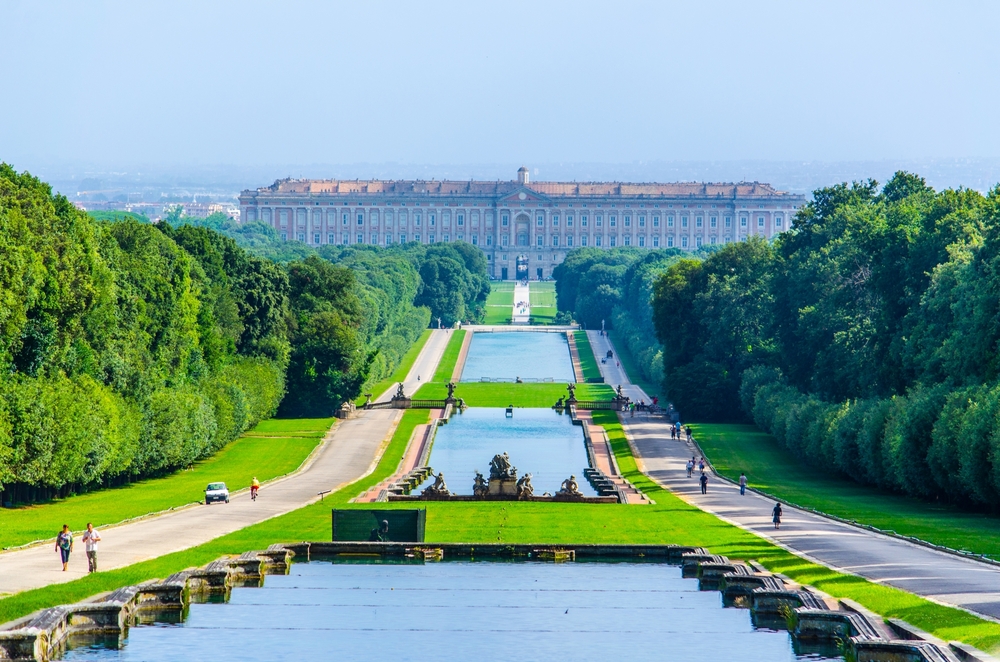
This palace was built in the 18th century as a royal residence for the Bourbon King of Naples, Charles VII, who was looking for an alternative administrative base for his kingdom away from the threat of a sea attack, and away from the revolt-prone and congested city of Naples. In fact, Charles VII never got to spend a single night in the building due to his abdication to become King Charles III of Spain. Instead it was his third son, Ferdinand IV of Naples, who saw the completion of the project. The palace was designed by Luigi Vanvitelli who was inspired by the Palace of Versailles. The palace is the largest in the world covering an area of 47,000 square metres. It is laid out over 5 floors and includes 1200 rooms and it took 50 years to build. The palace was the centrepiece of the new city of Caserta and was truly ahead of its time. The surrounding park is just as impressive and is similarly inspired by the park at Versailles. The aqueduct was essential to provide water for the palace and was an incredible feat of engineering, stretching 38 km. It became a UNESCO World Heritage site in 1997.
Archaeological Area of Agrigento, Sicily
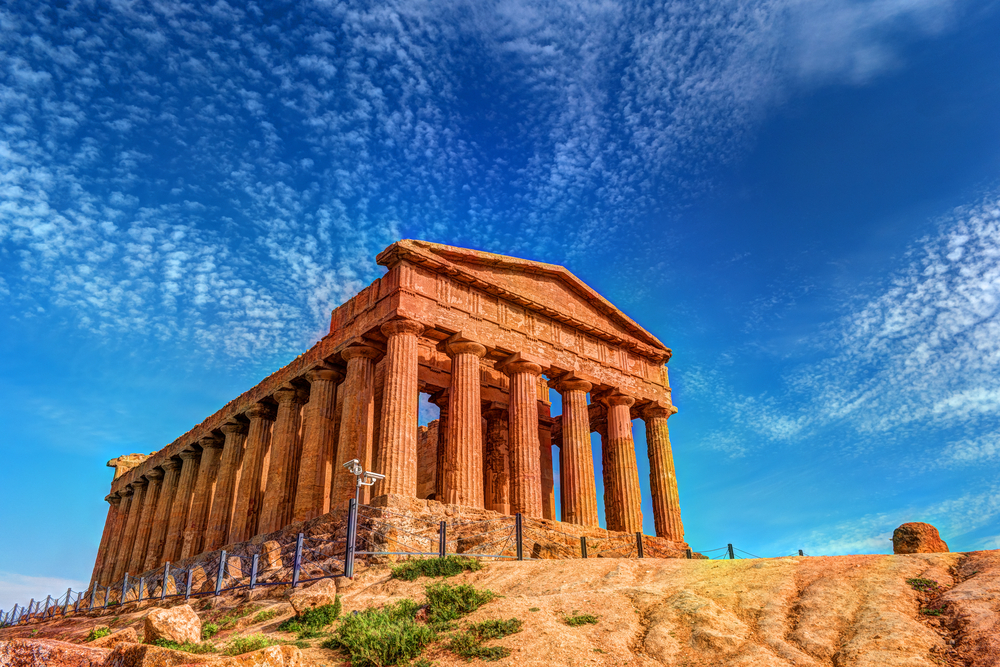
Back in the 6th century BC, Agrigento was founded as a Greek colony. In the following years, it became one of the leading cities in the Mediterranean. Nowadays, the archaeological area of Agrigento (known as the Valley of the Temples), is a vast and incredibly well preserved historical site, covering over 3200 acres, and situated on the southern coast of Sicily. It incorporates an array of Doric temples and buildings including the Temple of the Dioscuri and the Temple of Olympian Zeus which is certainly the greatest Doric temple in the Western world, measuring over 30 metres tall and with enormous statues over 8 metres tall placed between the temple’s columns. Unfortunately not all of these have survived but visitors can still see a copy of one of these enormous statues (telamon) lying next to the ruins so that you can appreciate the scale of the building. The original is Regional Archaeological Museum of Agrigento. The site is also home to the Temple of Heracles, probably the oldest of the buildings, the Temple of Hera Lacinia and the Temple of Concordia which is the building that remains most in tact today since it was converted into a Christian Church in the sixth century AD. Also within the site visitors can view ingenious aqueducts, mosaics from ancient residential homes and other Greek and Roman public buildings.
Arab Norman Palermo and the Cathedral Churches of Cefalu and Monreale, Sicily
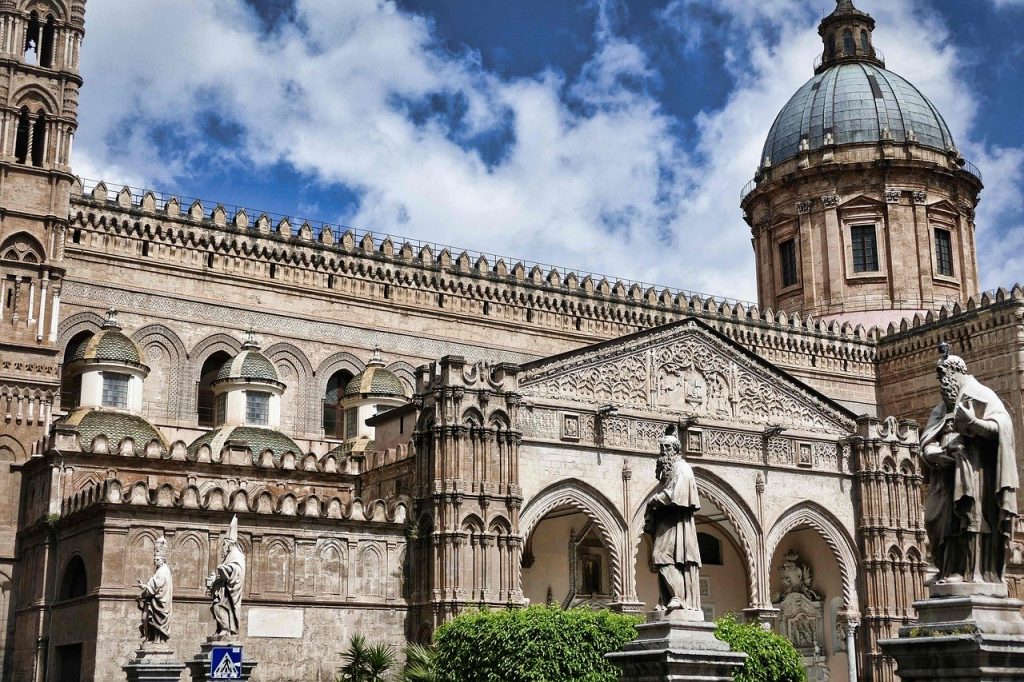
A UNESCO world heritage site since 2015, this encompasses 9 different monuments. Seven of these are in the city of Palermo itself – the Royal Palace with the Palatine Chapel, the church of San Giovanni degli Eremiti, the church of Santa Maria dell’Ammiraglio, the church of San Cataldo, the Palazzo della Zisa, the Admiral’s Bridge and Palermo Cathedral – whilst Cefalu Cathedral and Monreale cathedral are outside.
Mount Etna, Sicily
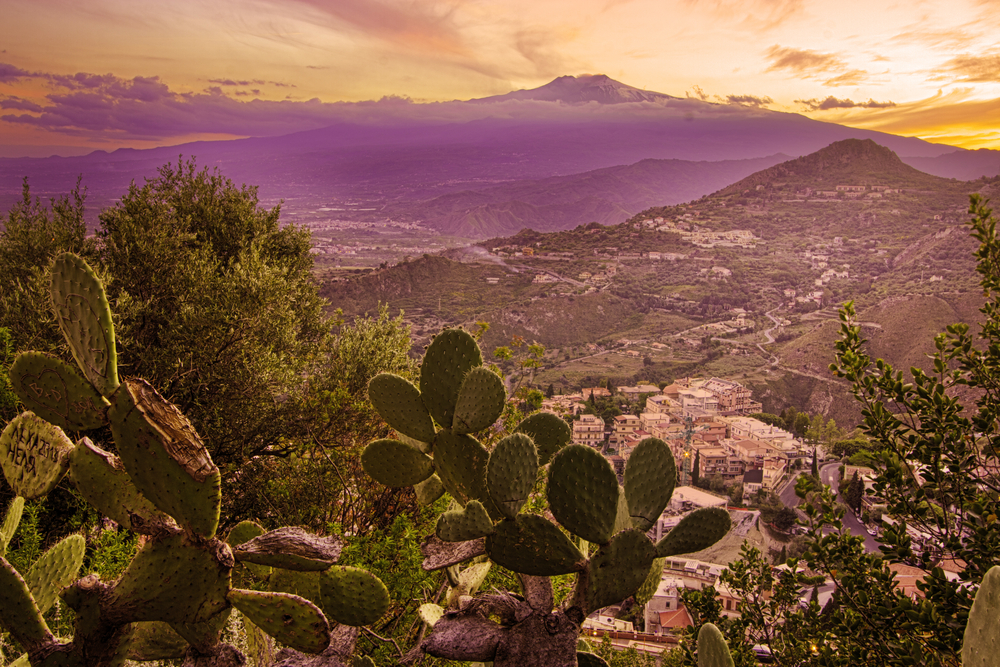
Mount Etna, Europe’s most active volcano, has been a UNESCO world heritage site since 2013 but its documented history dates back centuries before to ancient Roman times. It currently measures over 3300 metres high but its exact height can vary dependent on eruptions. Protected by the Etna Natural Park, the landscape around the volcano can be almost lunar at times but it’s also extremely fertile, home to forests of oak and chestnuts, orange groves and vineyards. Visitors can explore the many paths that lead up the side of the volcano and are rewarded with the most magnificent views from the summit, stretching all the way to the Island of Malta on a clear day. And its a popular spot in the Winter months too, when it is possible to ski down its slopes.
Monte San Giorgio
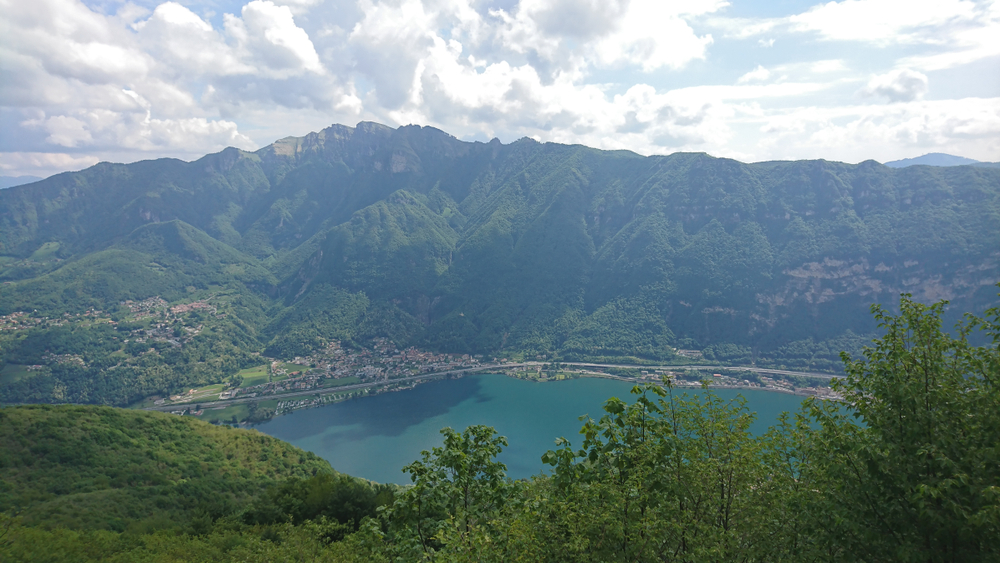
Monte San Giorgio is a pyramid-shaped, wooded mountain that overlooks Lake Lugano. Nestled between Switzerland and Lombardy, the Swiss side of the mountain was actually awarded UNESCO world heritage status back in 2007 but the Italian side only secured this status 3 years later in 2010. The mountain is regarded as the best fossil record of marine life from the Triassic Period. Exceptionally preserved fossils have been discovered here dating back over 250 million years. In total over 21,000 have been found to date, including reptiles, fish, bivalves, ammonites, echinoderms and crustaceans. For those with an interest in fossils, it is worth also heading to the archaeological museum in Besano where many of the fossils are on display.
Rock drawings in Valcamonica, Lombardy
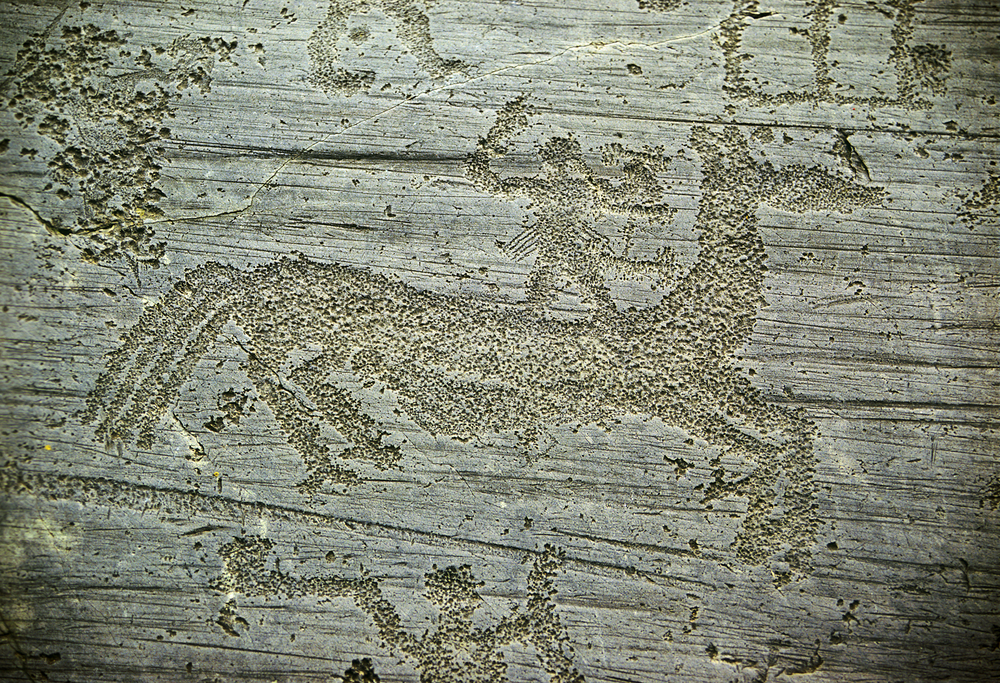
The rock drawings in Valcamonica are located in the province of Brescia in Lombardy in Northern Italy along the Camonica valley. Here you will find one of the worlds largest prehistoric rock collections, home to more than 140,000 different rock symbols and figures which have been carved into the rock over a period of 8,000 years. The carvings are most commonly images from agriculture, deer hunting or sometimes magic.
The Dolomites
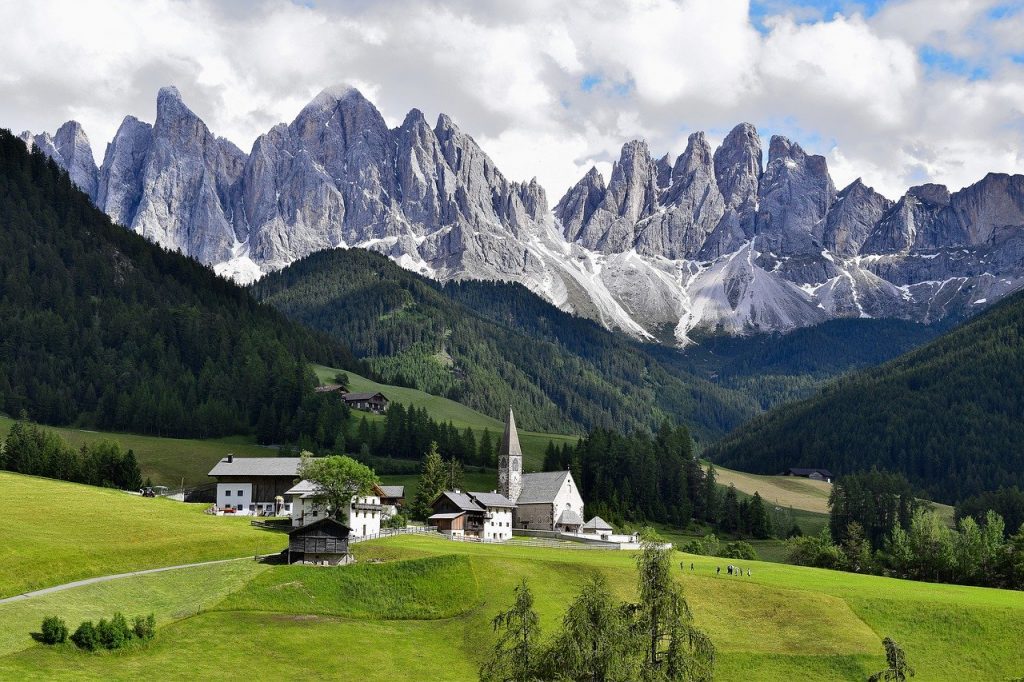
The Dolomites are an incredibly beautiful mountain range in Northern Italy. With 18 impressive peaks rising above 3000 metres in height, the highest of which is Marmolada, and stretching 90 km North to South and 100 km East to West, this must be the largest UNESCO world heritage site in Italy. The Dolomites are simply stunning and the landscape is both dramatic and awe inspiring with rivers and valleys, vertical walls and sheer cliffs.
City of Verona
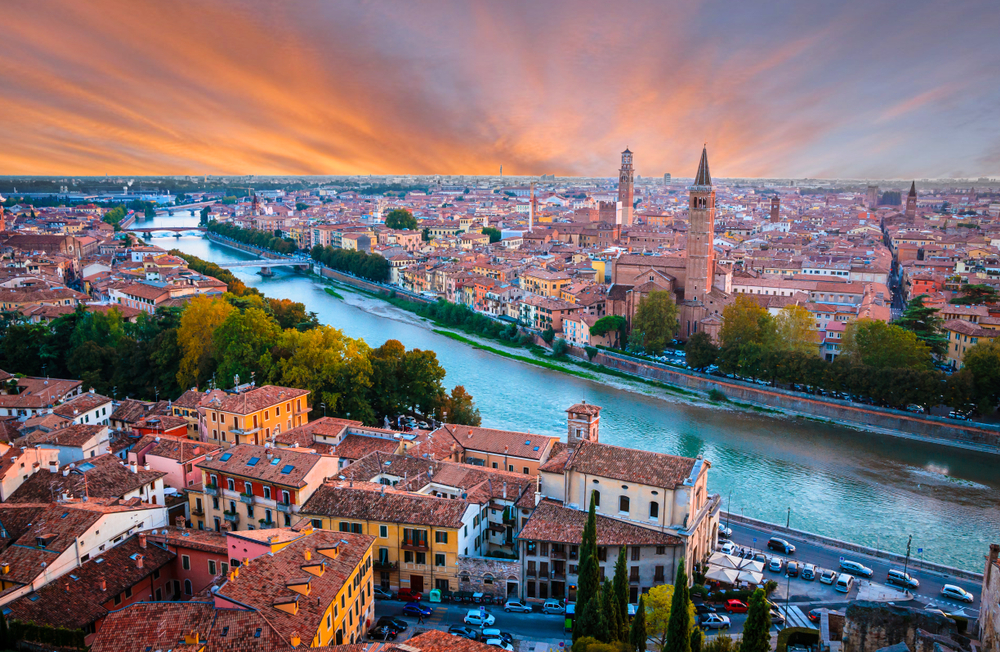
Awarded UNESCO world heritage status in 2000, Verona is one of our favourite cities in Italy. The history of the city stretches back 2000 years back to antiquity when it was an important urban centre for the Romans due to its geographical location. A number of key Roman artefacts remain today including the Arena, the Gavi Arch at Porta Borsari and the archaeological site at Porta Leoni. However, Verona’s subsequent history is also of key interest including the period in the 13th and 14th centuries when it was under the rule of the Scaliger Dynasty and then also during the Swabian reign, to the domination by the French and Austrians and then, of course, during the Italian Risorgimento.
The Sassi of Matera and the Park of the Rupestrian Churches of Matera
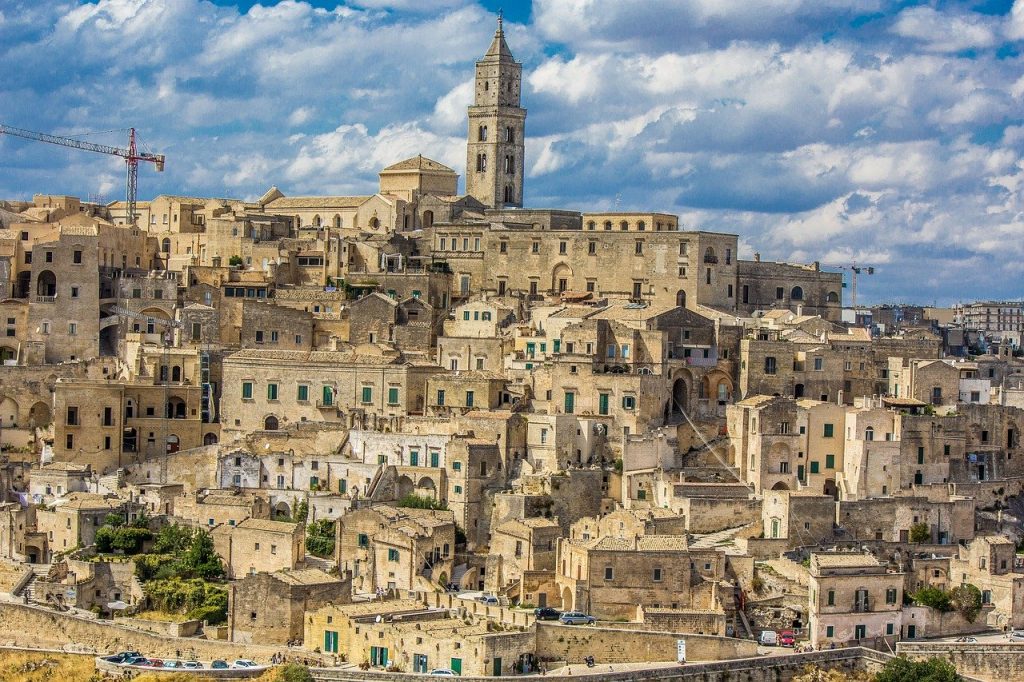
Declared a UNESCO world heritage site back in 1993, the sassi are essential homes carved into the rock. Overall, the UNESCO site includes a whole complex of houses, churches, hermitages and monasteries that have been built into the natural caves of the Murgia. In total there are more than 1000 dwellings, shops and workshops. The area dates back to the Palaeolithic period and has been continually inhabited through to the modern day. Today, visitors can experience what it would have been like to live in the sassi for themselves by visiting the Sasso Barisano.
The Amalfi Coast
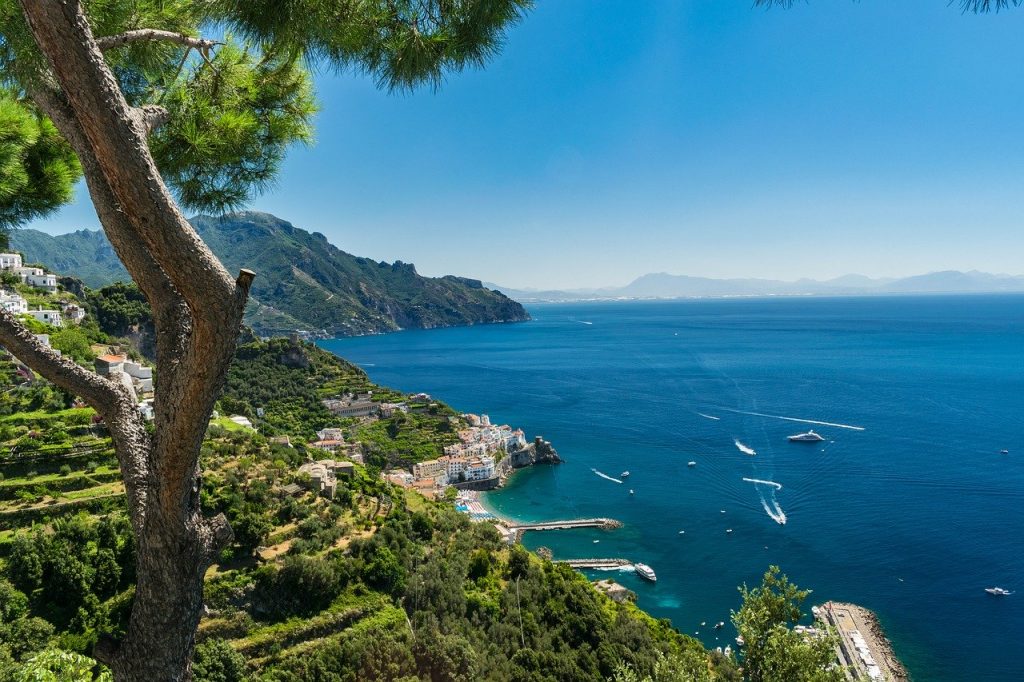
The Amalfi Coast needs no introduction. Chosen to be added to the ranks of UNESCO world heritage sites as an outstanding example of a Mediterranean landscape, it covers an area of over 11,000 hectares between the Gulf of Naples and the Gulf of Salerno. Communities have settled on the coastline since the early Middle Ages and, as a result, the area also includes a number of towns such as Amalfi, Ravello, Atrani, Maiori, Minori and Vietri sul Mare which are of great architectural and artistic importance too. The landscape is characterised by upland pastures, terraced slopes planted with vineyards and orchards and dramatic cliffs which contrast with the azure coloured sea below.
Ferrara and the Po River Delta, Emilia Romagna
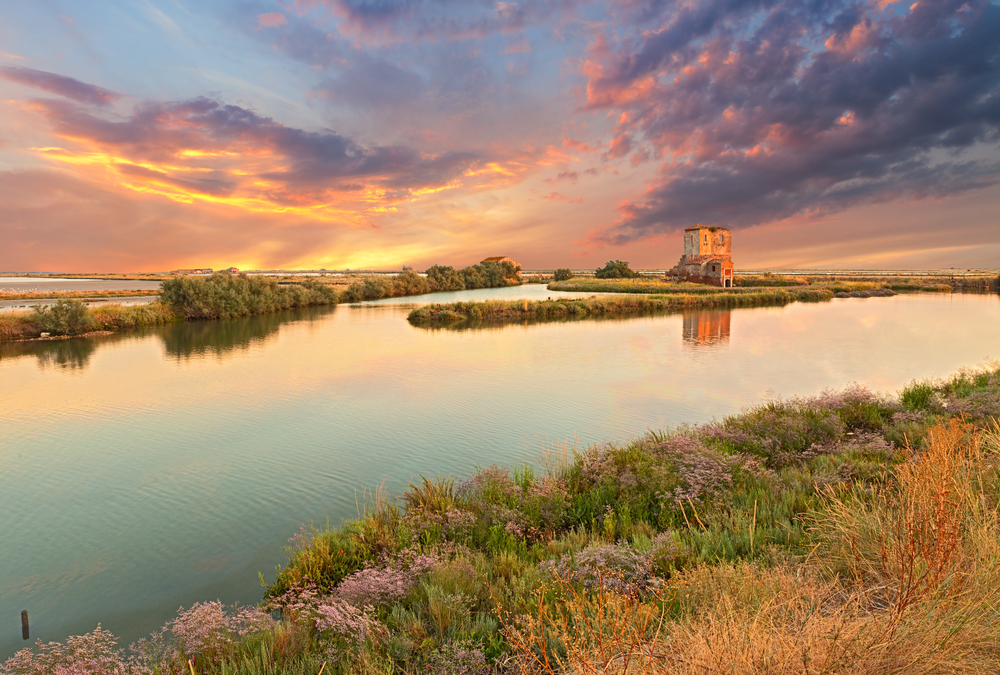
Ferrara has been included in the World Heritage list since 1995 and this status was extended to include the Po River Delta four years later. Ferrara is the realisation of the ‘ideal city’ thanks to the work of Biagio Rossetti from 1492 onwards, and it has had a major influence on modern town planning. Under Rossetti, for the first time, the network of streets were closely linked with the grand palaces, churches and gardens which meant that the whole effect worked harmoniously together in contrast to what had happened in the past when key buildings had been accentuated but with no thought to the wider picture. Some of the most important architectural gems worth visiting include the cathedral dating back to the 12th century, the Castello Estense in the Piazza della Repubblica, the Palazzo Municipale, the Palazzo Schifanoia and Palazzo dei Diamanti.
Piero della Francesca, Andrea Mantegna and Jacopo Bellini decorated these great palaces of the House of Este during the Italian Renaissance of the 15th and 16th centuries when Ferrara was also an important intellectual and artistic centre.
The Po Delta Park incorporates a group of approximately 30 villas in total used by the Este family for their leisure and for hunting. The Po Delta itself is also an important natural ecosystem. During the Renaissance period, the area’s swamps were reclaimed for use as fertile land. Nowadays, visitors can enjoy the area on foot or on horseback, by bike or by boat.
Pompeii, Herculaneum and Torre Annunziata
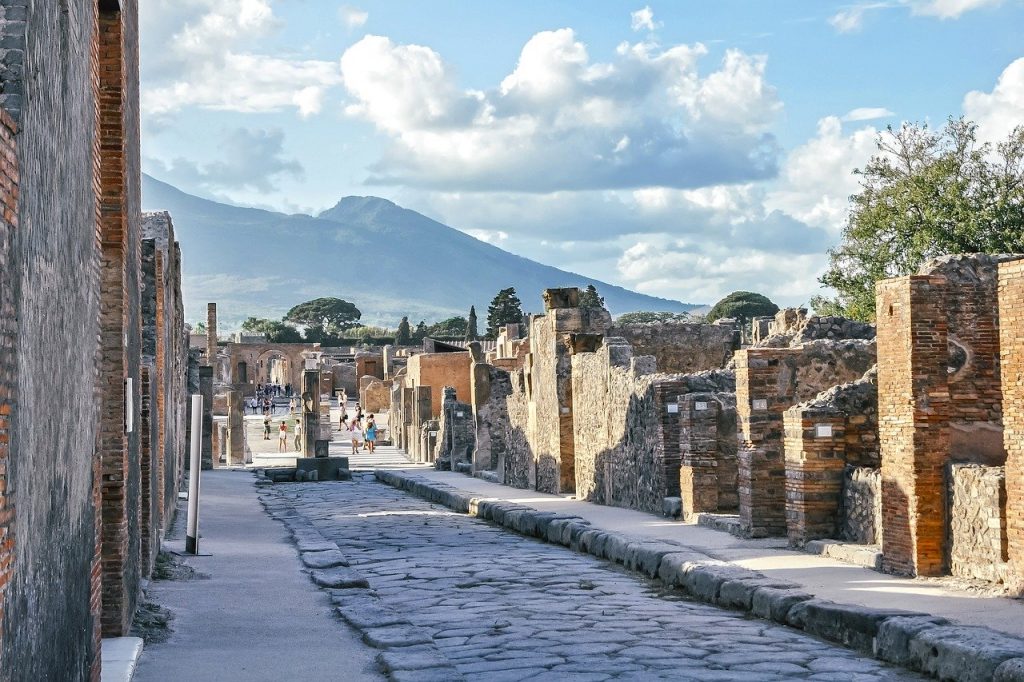
The most famous of the three, Pompeii is a vast archeological site. Whilst Pompeii was buried by a thick layer of stones, ash and lava by the eruption of Mount Vesuvius in 79AD, neighbouring Herculaneum was buried beneath a wash of volcanic mud. However, both sites offer an incredible glimpse into what life was like in Roman times. Many public buildings remain in Pompeii including the Capitolium, Basilica and the public baths however there are also many houses here too including the Surgeon’s House, those of the Faun and the Chaste Lovers as well as the House of Mysteries. And visitors can walk along its old streets to really get a snapshot and record of what daily life was like at a very specific moment in our history.
We know less about Herculaneum’s history and past however its buildings are actually better preserved than those in Pompeii. The baths and theatre here, along with the College of the Priests of Augustus are all pretty much completely in tact. And it is also home to a number of beautiful sculptures, mosaics and wall paintings.
Torre Annunziata was once called Oplontis and suffered the same fate as its nearby neighbours. Here, you will find the Villas of Poppaea and of Lucius Crassius Terzius.
City of Rome
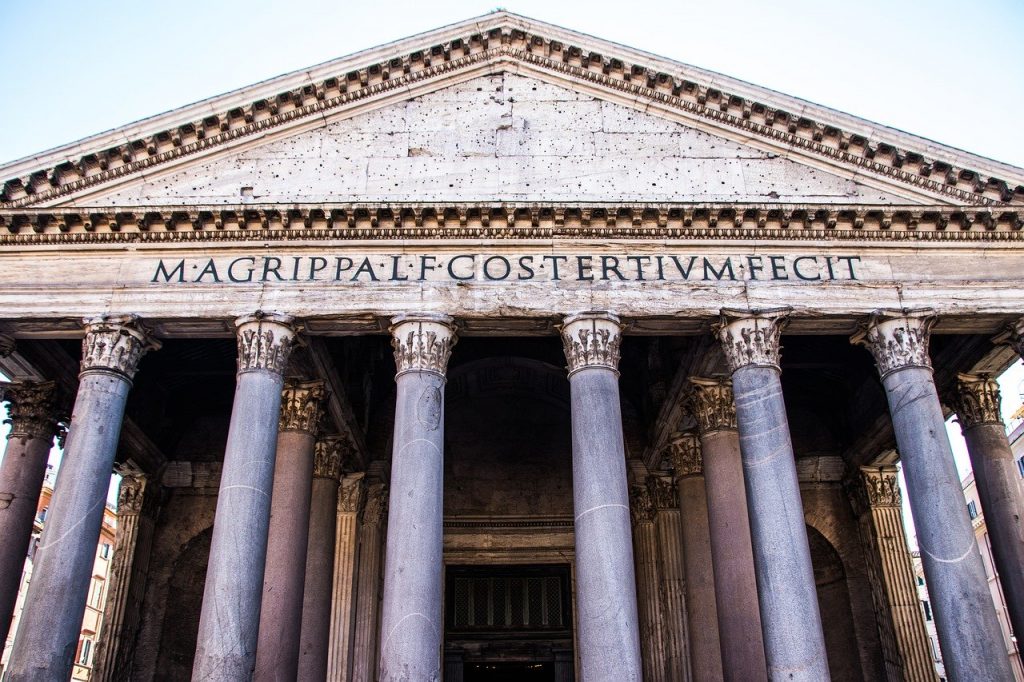
Even if you have not visited Rome, you must be familiar with its key historical attractions so it’s not surprising that the historic centre of Rome was made a UNESCO world heritage site in 1980. According to legend, Rome was founded in753 BC by Romulus and Remus. It was not just the centre of the Roman Republic but also the Roman Empire and then the Christian world from the 4th century. The world heritage sites include the Roman forums, the Mausoleums of Augustus and of Hadrian, the Pantheon, Trajan’s Column and the Column of Marcus Aurelius, as well as the religious and public buildings of papal Rome.
Archaeological Area and the Patriarchal Basilica of Aquileia
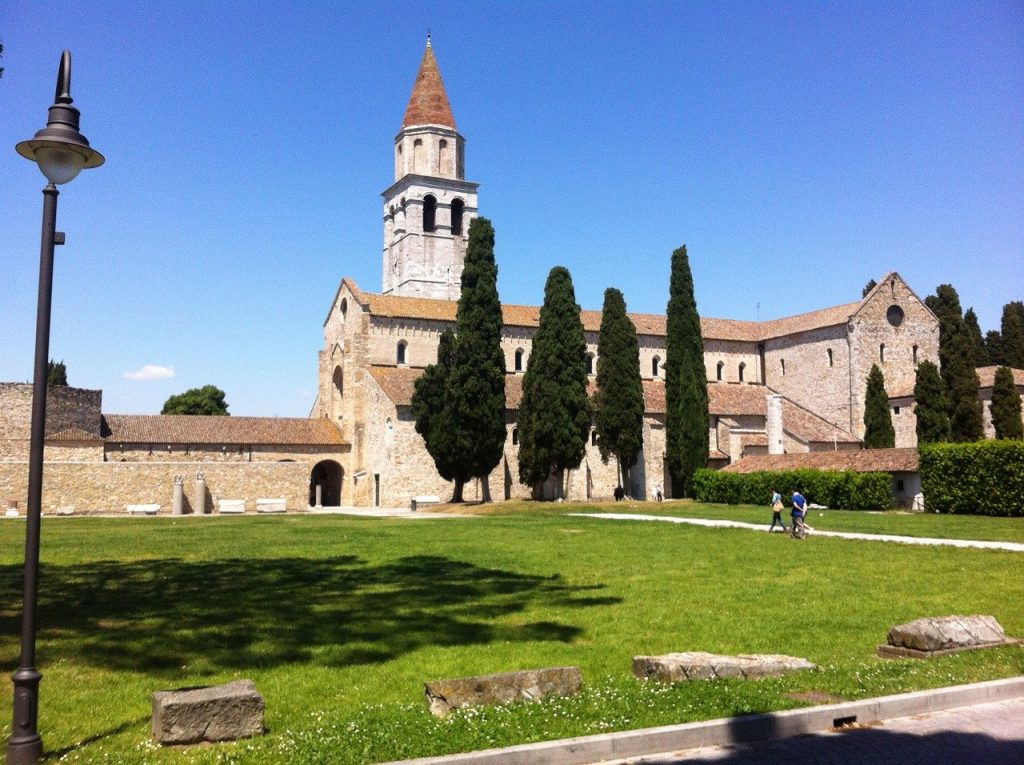
Aquileia was one of the richest and biggest Mediterranean cities within the Roman Empire, after which it become a centre of the Christian world from the Middle Ages through to the 18th century. Its Roman roots are still visible today and visitors can see the partial remains of the Roman forum, basilica, the macellum (indoor food market), the baths and the Mausoleum as well as residential complexes, defensive walls, the amphitheatre and the Sepolcreto Romano, (racing arena).
For a glimpse into its later Christian past, don’t miss Aquileia’s Baptistry and Patriarchal Basilica completed in 1031 but which is home to some incredible 4th century mosaics depicting scenes from the Old Testament. These were discovered in the 1900s when the flooring that had been laid in later centuries was removed.
For those that wish to learn more about the history of Aquileia, check out its museums: the National Archaeological Museum, the Paleochristian Museum and the Civic Museum of the Patriarchate.
The Basilica of San Francesco and other Franciscan sites in Assisi, Umbria
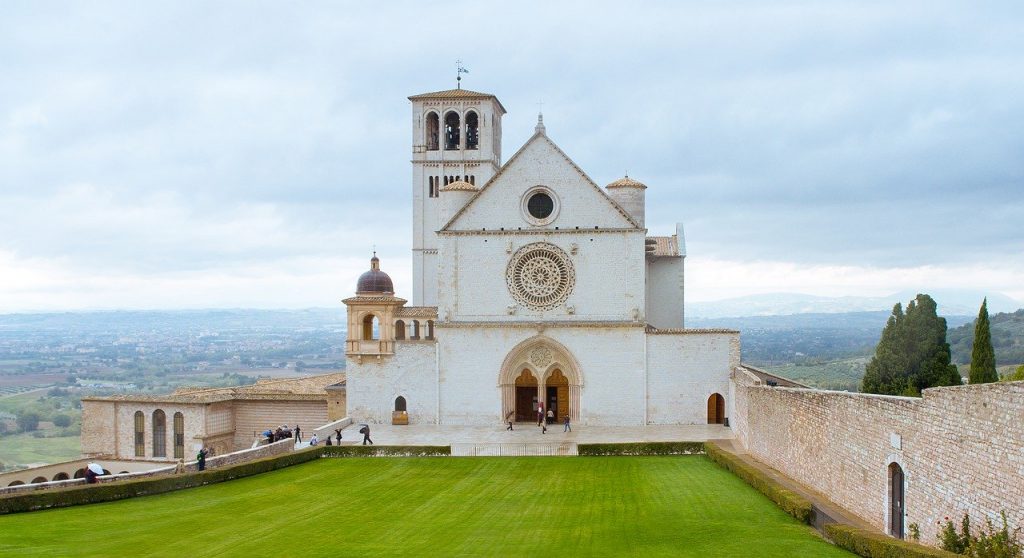
The birthplace of St Francis, Assisi is a gorgeous hilltop town in Umbria that attractions hundreds of thousands of visitors each year. By far the most famous site here is the Basilica di San Francesco, attracting a multitude of pilgrims each year and consisting of both an Upper Basilica (home to frescoes by Cimbue and Giotto) and the Lower Basilica, home to the remains of the saint. However, there are other less grand but just as beautiful religious sites to discover. Just outside Assisi is Eremo where St Francis went for spiritual contemplation, whilst resting just below the city is the Basilica of Santa Maria degli Angeli, home to a tiny church called Porziuncola, where Francis ministered and prayed, and where he died. It is a lovely, emotionally moving chapel.
If you’d like to visit Assisi, then a villa in Spello is a great option. This luxury 3 bedroom villa in Spello is within a picturesque cycle ride of Assisi. Sleeping up to 6 guests, boasting a private pool and within walking distance of restaurants, it’s a great option for those looking to journey to Assisi.
Orto Botanico di Padova
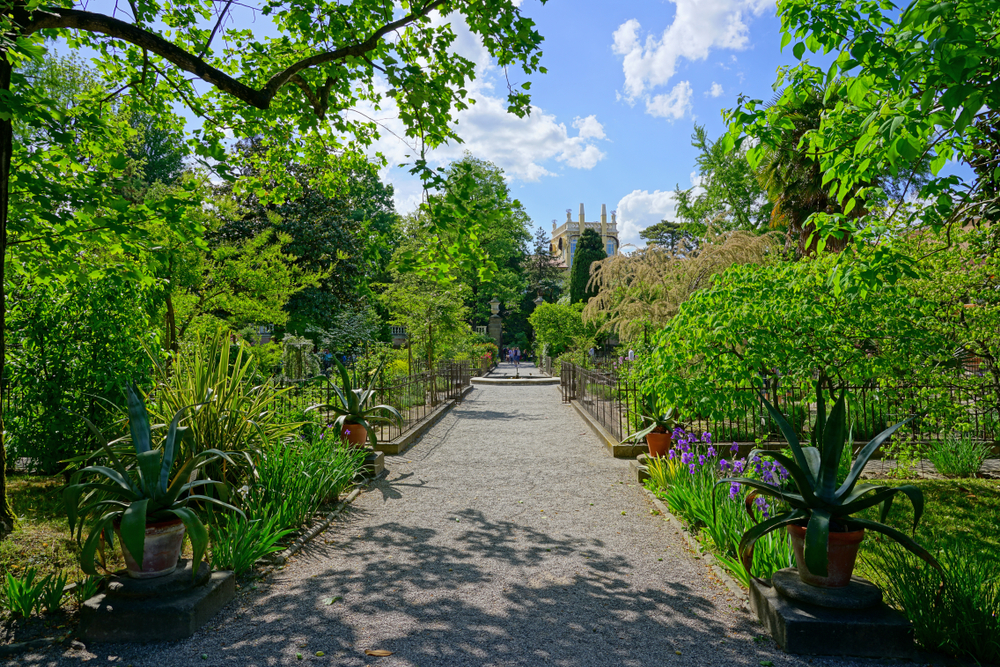
Founded in 1545, the Botanic Gardens of Padua are the oldest in the world. Set up by the Venetians, it was originally a medicinal garden to grow plants and herbs which had healing and therapeutic properties hence its original name – Giardini dei Semplici or Horti simplicium. Over the years, the breadth of plants in the gardens has increased and its now home to around 6000 different species, the oldest of which is the Palma di Goethe which dates back to 1585 and is so called because it inspired the German writer who was visiting Padus in 1786 to write a theory on the metamorphosis of plants.
Castel del Monte, Puglia
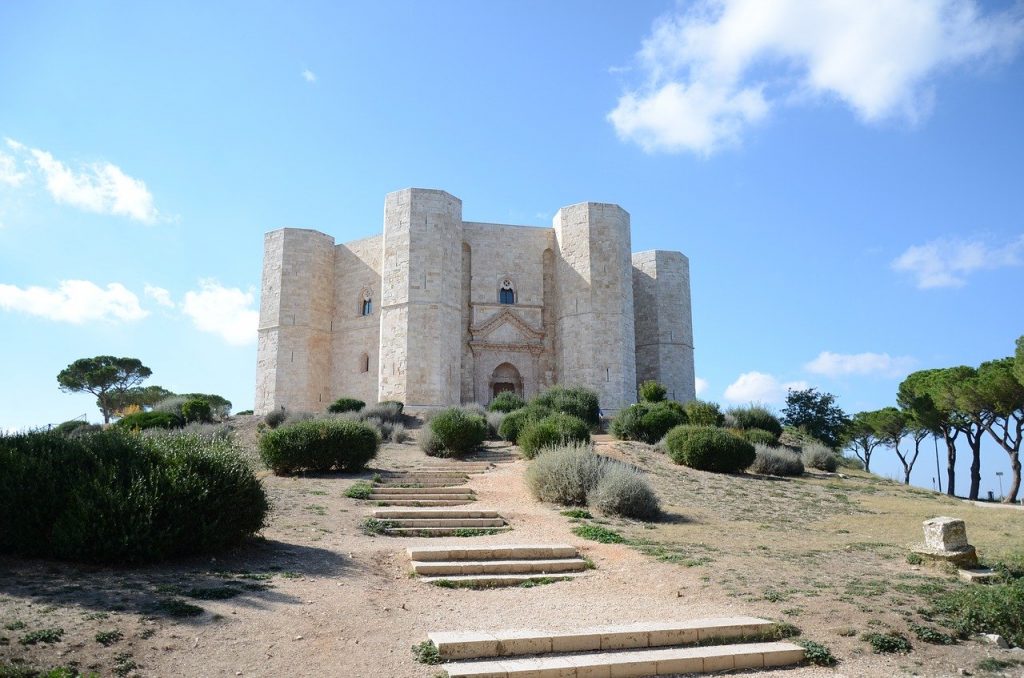
A 13th century octagonal castle built for Frederick II, Castel del Monte is a unique example of military architecture situated in Andria, Puglia which combines a variety of styles from classical antiquity to the Islamic Orient and to the North European Gothic style. For those interested in useless facts, the castle also appears on the Italian 1 euro coin.
Modena Cathedral and Torre Civica, Piazza Grande, Modena, Emilia Romagna
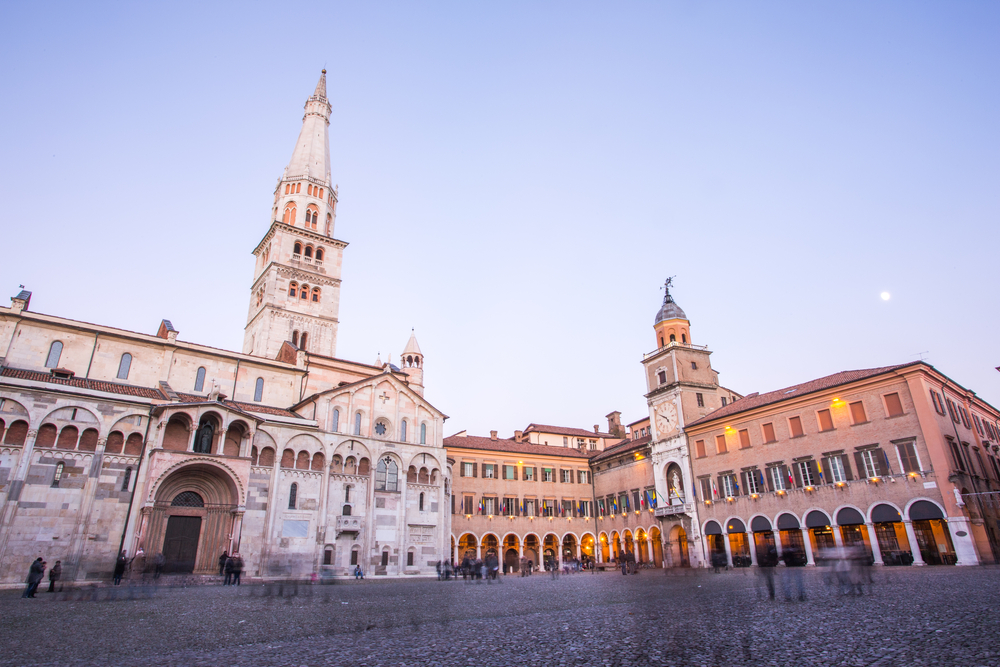
The 12th-century cathedral in Modena is a perfect example of Romanesque art. Commissioned by the Canossa dynasty and the work of two great artists – Lanfranco and Wiligelmus – is a supreme example of early Romanesque art with a soaring tower. It’s also home to the remains of Modena’s patron saint, Saint Geminiano. The soaring tower was originally to be five stories high but by the time it had been completed, it had an additional octagonal section and decoration. The cathedral sits in the Piazza Grande which also forms part of this UNESCO world heritage site, along with the City Hall, the Archbishopric and some of the canonical buildings and sacristy to the North.
Church of Santa Maria delle Grazie and Leonardo da Vinci’s ‘The Last Supper’
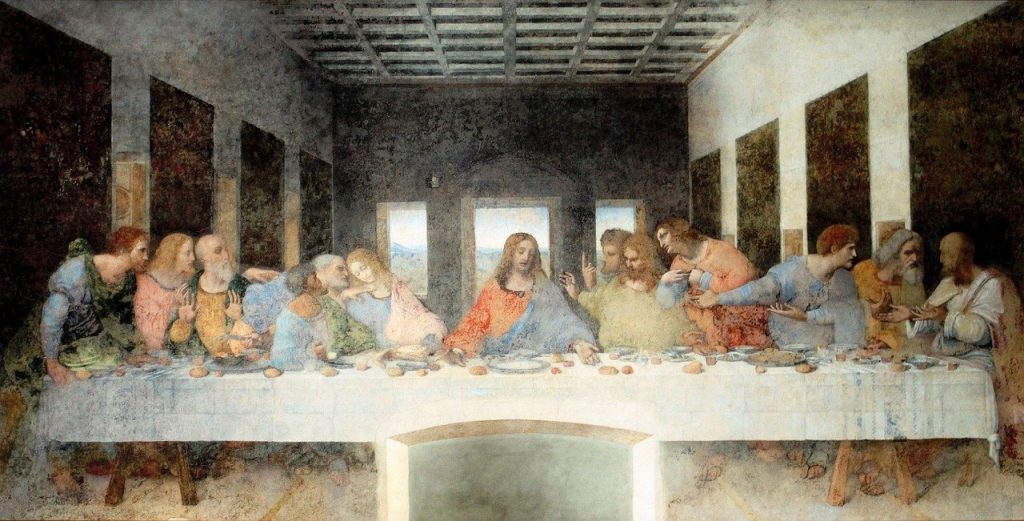
Leonardo da Vinci’s ‘The Last Supper’ is, without doubt, one of the world’s most famous artworks, and it is housed in the Church of Santa Maria delle Grazie in the heart of Milan. The church was actually hit and badly damaged by Anglo-American bombers during WWII but the painting miraculously escaped damage.
Whilst the church is probably most famous for the artwork kept preserved within its refectory, the building itself is well worth a visit. Much of the architecture is attributable to Bramante and it is a symbol of Renaissance Milan. Both the 15th century church and the painting became a UNESCO world heritage site in 1980.
Parco Nazionale del Cilento, Vallo di Diano e Alburni and the archeological sites of Pestrum and Velia and the Certosa di Padula
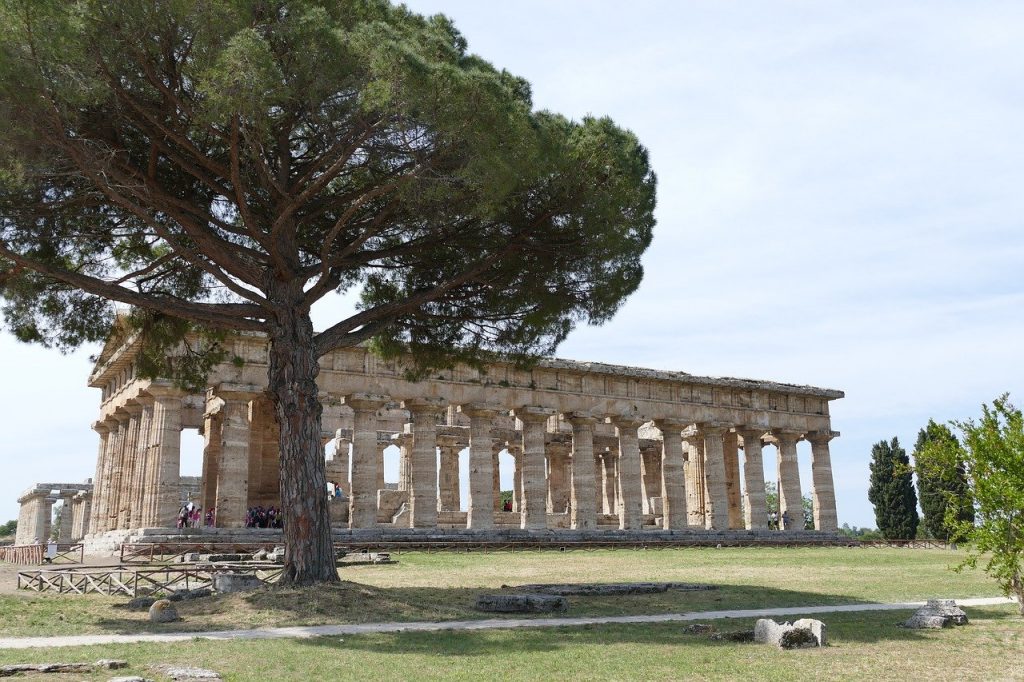
The Parco Nazionale del Cilento, Vallo di Diano e Alburni is one of Italy’s national parks founded in 1991 to protect the area from mass tourism and building. Along with the ancient Greek towns of Paestrum, Velia and the Padula Charterhouse which sit within it, it became a UNESCO world heritage site in 1998. The most noteworthy of these three sites is Paestrum (known as Poseidonia by the Ancient Greeks) which was founded at the end of the 7th century BC. Nowadays, visitors can still see the three ancient Greek temples which have been excellently preserved along with the city walls and amphitheatre as well as a number of other structures and roads.
City of Vicenza and the Palladian villas of the Veneto
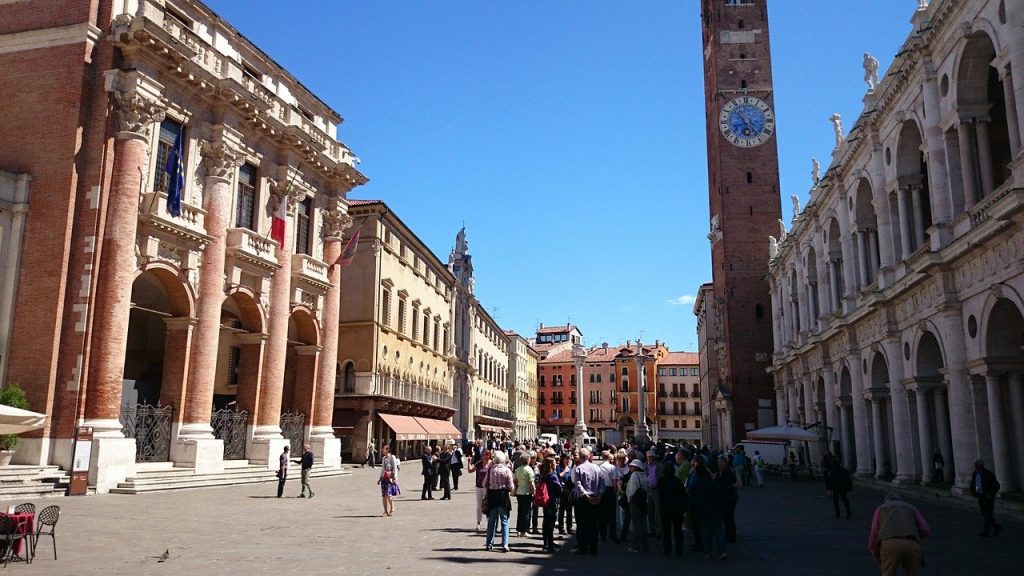
This Italian UNESCO site incorporates the city of Vicenza and the Palladian villas of the Veneto that were designed by 16th century architect, Andrea Palladio (1508-1580). In total there are 24 villas scattered throughout the area. Vicenza itself is affectionately known as ‘la citta di Palladio.’ Based on classical Roman architecture, Palladio’s distinct style was born in Vicenza but spread to much of the rest of Europe, including England, and then beyond to North America, becoming an architectural movement without parallel. Many of Palladio’s original buildings still exist in Vicenza today.
Crespi d’Adda, Bergamo, Lombardy
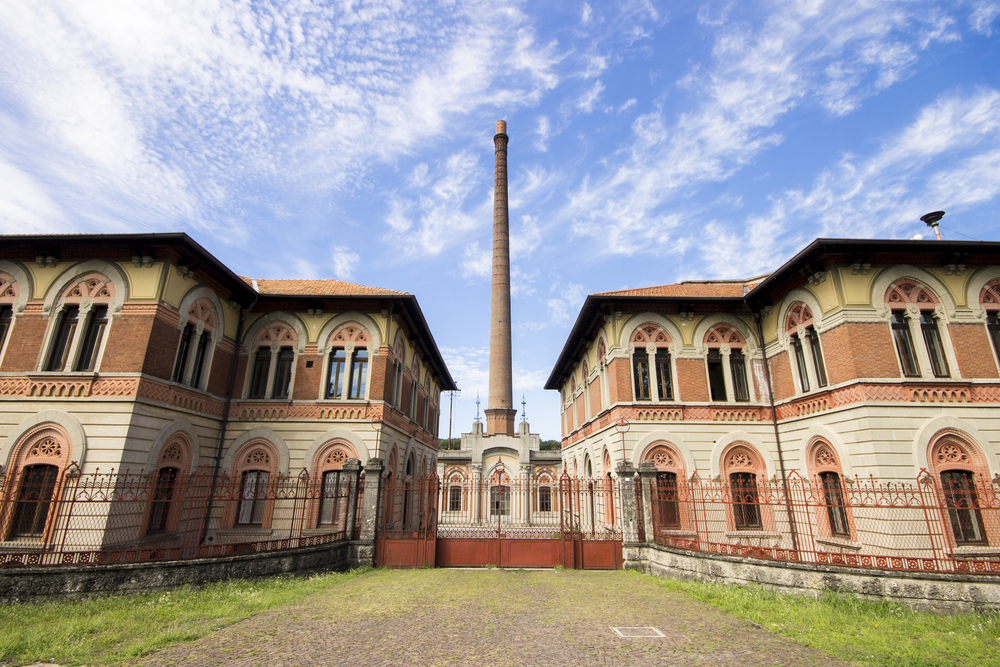
Crespi d’Adda is a superb example of one of the 19th and early 20th century ‘company towns’ which were built in both Europe and North America by enlightened industrialists in order to meet and care for workers’ needs. It became an Italian UNESCO world heritage site in 1990.
Crespi d’Adda was founded by Cristoforo Benigno Crespi and his son to provide comfortable homes and services for those who worked in their textile factory. Houses had their own gardens and there were a number of communal facilities including public lavatories, a school, a theatre, sports centre and even a hydroelectric power station which supplied the workers with free electricity. The site was completed in the late 1920s and remained under the ownership of a single company until the 1970s when many of the buildings were sold to private individuals. Even today it remains remarkably intact and is still partly used for industrial purposes, although changing economic and social conditions do threaten its survival.
Early Christian Monuments of Ravenna
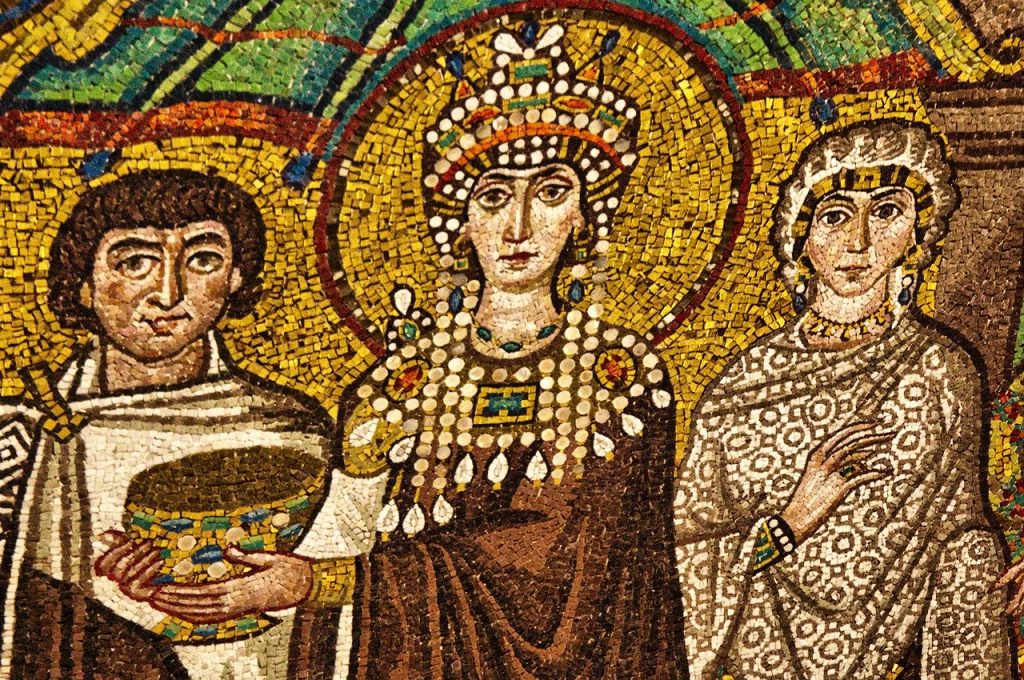
Ravenna is a fascinating city in Emilia Romagna which gained UNESCO world heritage status in 1996 due to the importance of the city’s artistic and historic religious complex dating back to the Paleochristian era. Eight monuments are included – the Galla Placidia Mausoleum (home to some superb, richly coloured mosaics), the Mausoleum of Theoderic and the Baptistery of Neon (with its incredible mosaic decorated cupola), the Arian Baptistery (with another spectacular cupola), the Basilica di San Vitale, the Palazzo Arcivescovile and finally Sant’Apollinare in Classe just outside the city. The latter is famous for its mosaic depicting Ravenna’s Patron Saint. A visit to Ravenna offers the chance to be transported back to the Byzantine era via these well preserved monuments.
Etruscan Necropolises of Cerveteri and Tarquinia
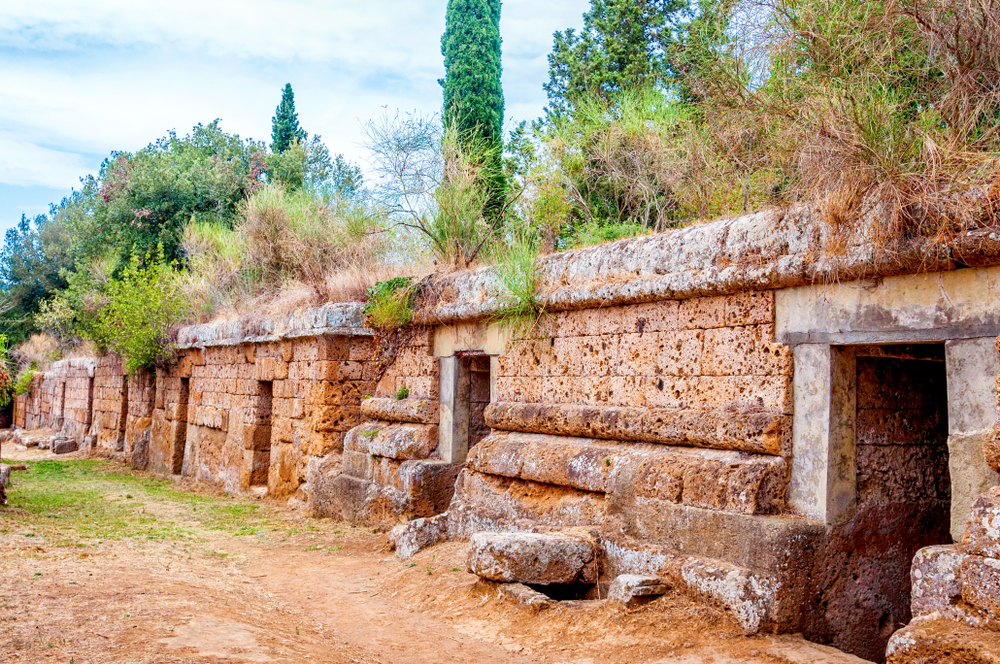
These are two large Etruscan cemeteries reflecting the burial practices in place from the 9th to the 1st century BC. The tombs vary considerably. Whilst some of the tombs are significant in size and topped with large tumuli (burial mounds), others are organised in grid-like streets, whilst others are trenches cut into the rock and others are carved in the rock in the shape of huts and houses. Some feature wall paintings. Of particular note here is the necropolis of Tarquinia, which contains 6,000 graves cut into the rock, 200 of which are painted tombs.
Historic centre of Florence
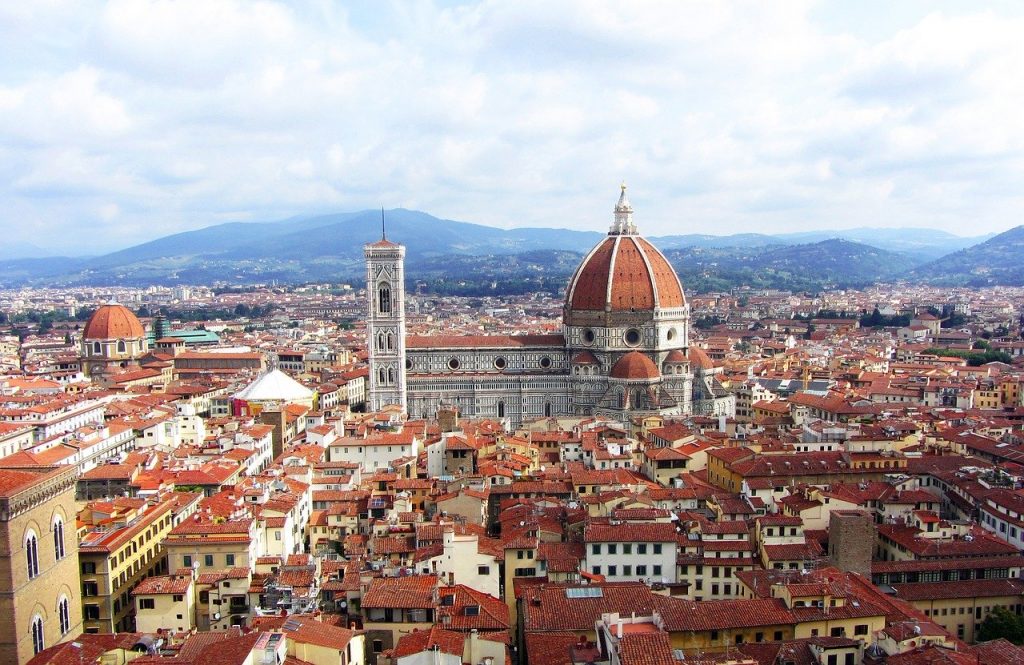
Just like Rome, Florence needs no introduction. Florence enjoyed its heyday under the Medici in the 15th and 16th centuries. The historic centre became a UNESCO world heritage site in 1982, incorporating monuments such as the 13th-century cathedral (Santa Maria del Fiore), the Church of Santa Croce, the Uffizi and the Pitti Palace. It also includes the work of great artists such as Giotto, Brunelleschi, Botticelli and Michelangelo.
Genoa: Le Strade Nuove and the system of the Palazzi dei Rolli
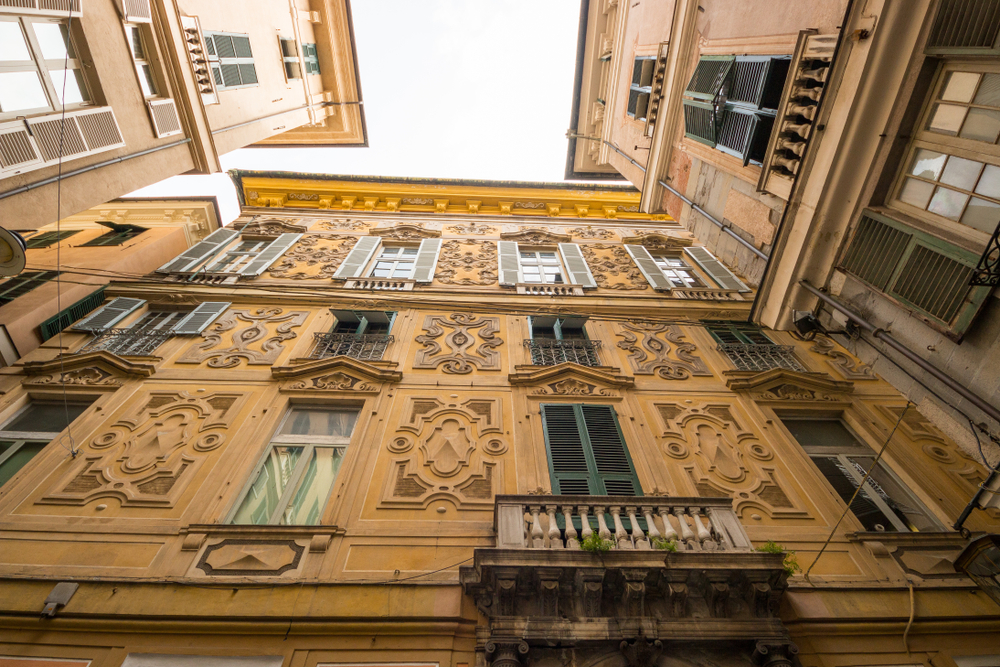
A UNESCO world heritage site since 2006, it includes the Strade Nuove (New Roads) and the 42 Palazzi dei Rolli which occupy them. The latter were built between the 16th and 18th centuries in both the Renaissance and Baroque styles as homes for the most important aristocratic families and the new governing classes in Genoa. They are all absolutely stunning architecturally. Some of our favourites include the Palazzo Rosso, the Palazzo Biano and Doria Tursi, all of which are now museums, as is the beautiful Palazzo Reale in Via Balbi. And we must also mention the Palazzo Doria Spinola.
Historic centre of Naples
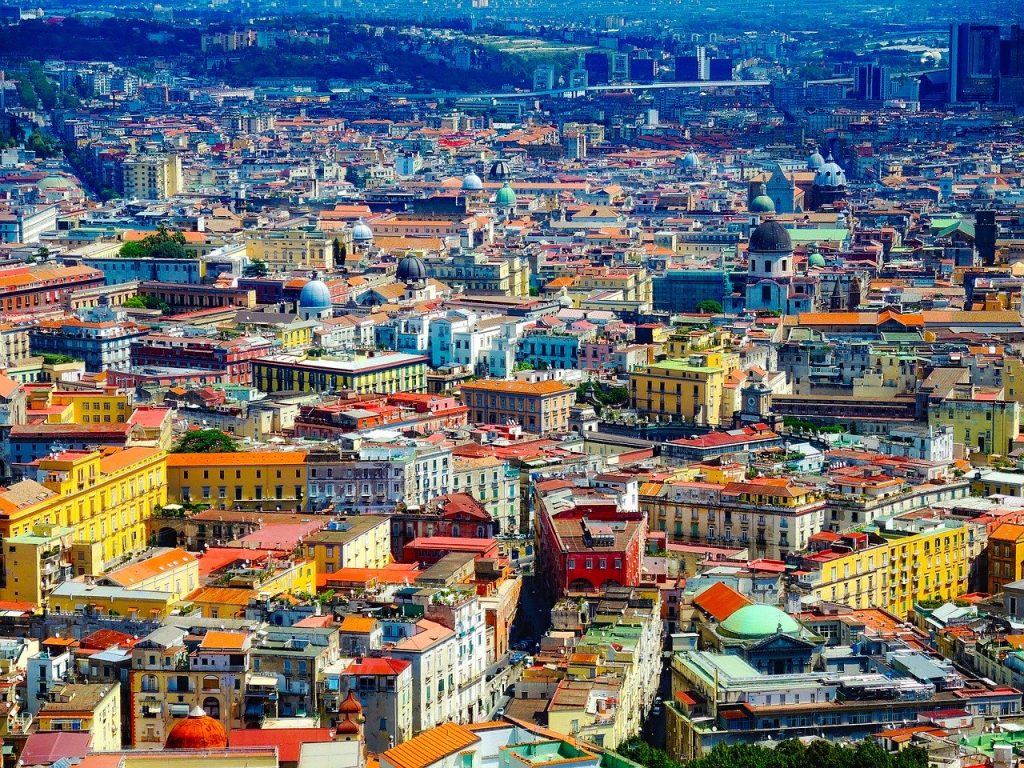
With the largest historic centre in Europe, Naples secured its spot as an Italian UNESCO world heritage site in 1995. The history of Naples is a fascinating one. Founded in the 8th century BC as the Greek colony – Neopolis – it was subsequently ruled by the Romans, Normans, Anjous, Aragonese, French before finally becoming part of the Kingdom of Italy during the unification period. Visitors can find traces of all these dynasties within the city.
Historic centre of San Gimignano
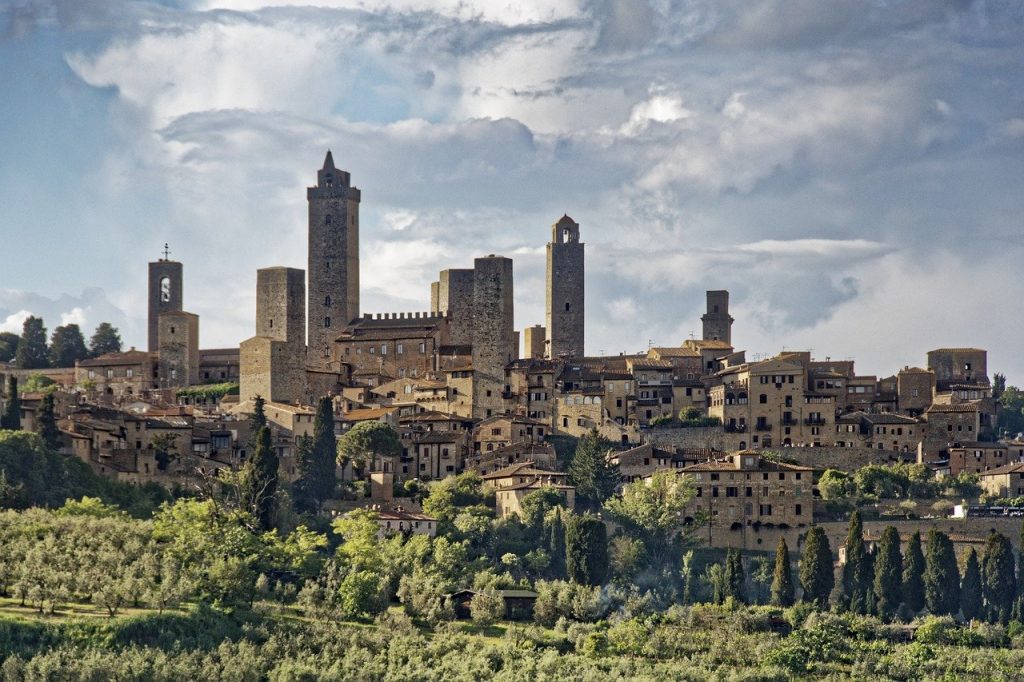
San Gimignano is on most people’s Tuscany bucket list. Enclosed within its 13th century walls stands an incredibly well preserved town dating back to the Middle Ages when the town flourished thanks to the stream of pilgrims and merchants that passed through it along the Via Francigena (the historic route that went from Northern Europe to the Eternal City). At that time, the town also witnessed a competition among the wealthy families to out-do their neighbours. Families attempted to build the highest tower as a demonstration of their power. This led to the Torre Comunale which stated that no other tower could be taller than one particular tower – La Rognosa – which put a stop to future towers being built even higher. Nowadays, of the 70 original towers, only 13 remain but they remain clearly visible and make San Gimignano one of the most recognisable skylines. Today, the town is also home to a number of superb artworks thanks to the great artists that also flocked here in the 14th century.
Historic centre of Siena
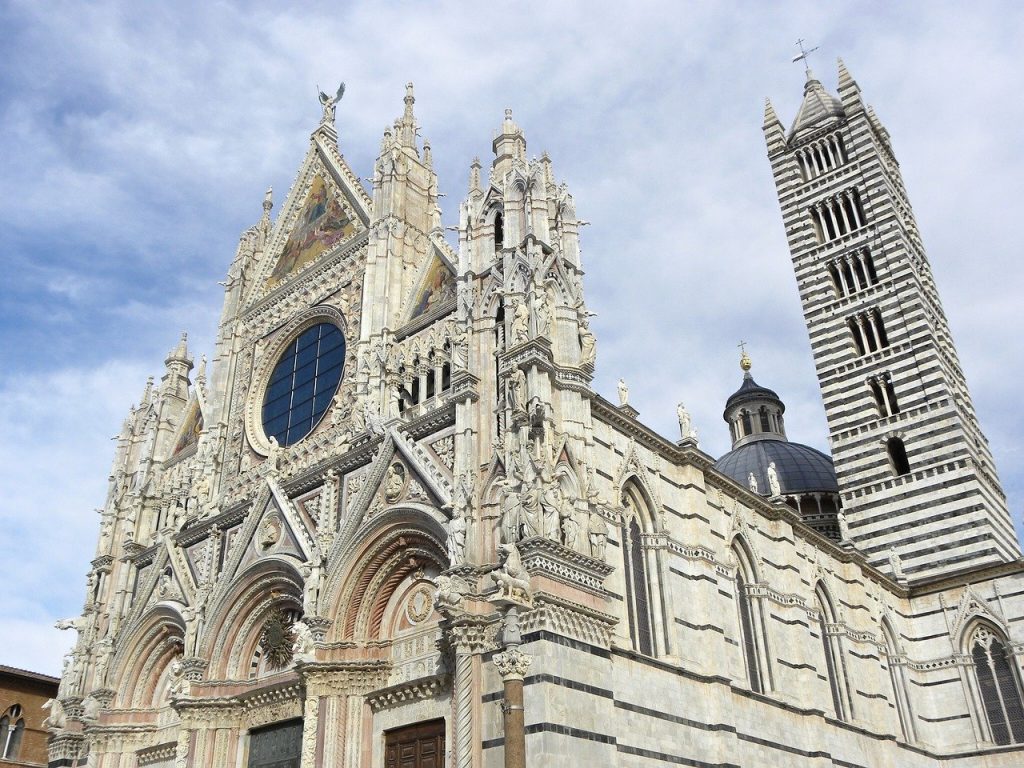
The ’embodiment of a medieval city’ according to UNESCO, Siena gained world heritage status in 1995. The city is built around the Piazza del Campo from which 3 main streets fan out in a Y shape up to the hills on which it was built. The Piazza del Campo is instantly recognisable and is home to the Duomo, the 345 foot Torre del Mamgia, the Palazzo Sansedoni and the Palazzo Pubblico. It is also where the annual palio takes place.
Historic centre of Pienza
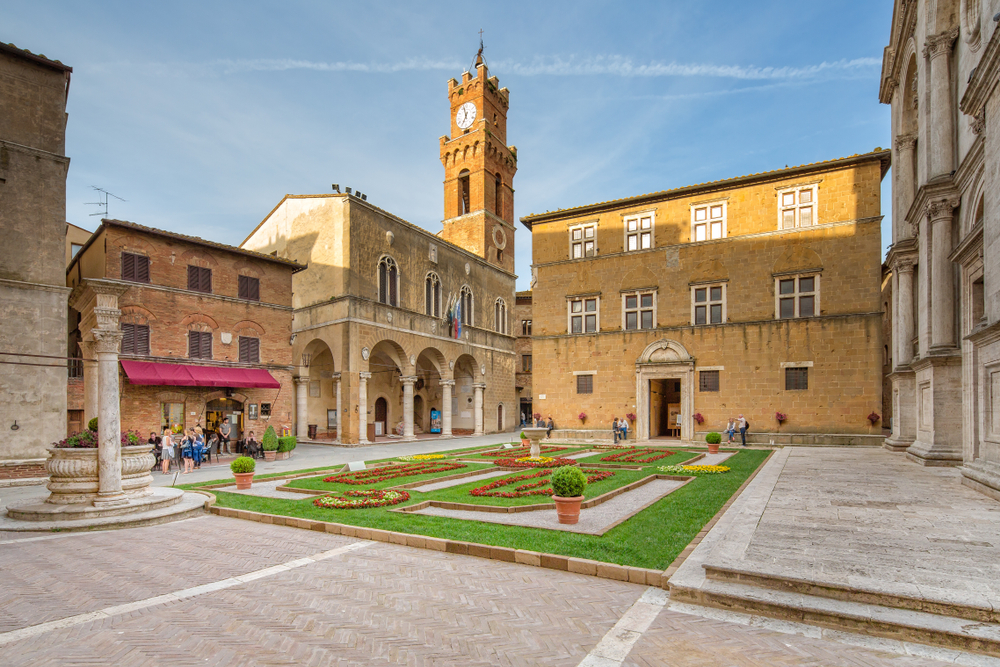
A Renaissance utopia, thanks to Pope Pius II who decided in the mid 15th century to transform his birthplace, Pienza is a beautiful town. Designed by architect Bernaro Rossellino, the piazzas and palazzi within it are organised according to humanist principles. Of particular note are the Cathedral of Santa Maria Assunta (Duomo), the Palazzo Piccolomini and the Palazzo Borgia.
Historic centre of Urbino
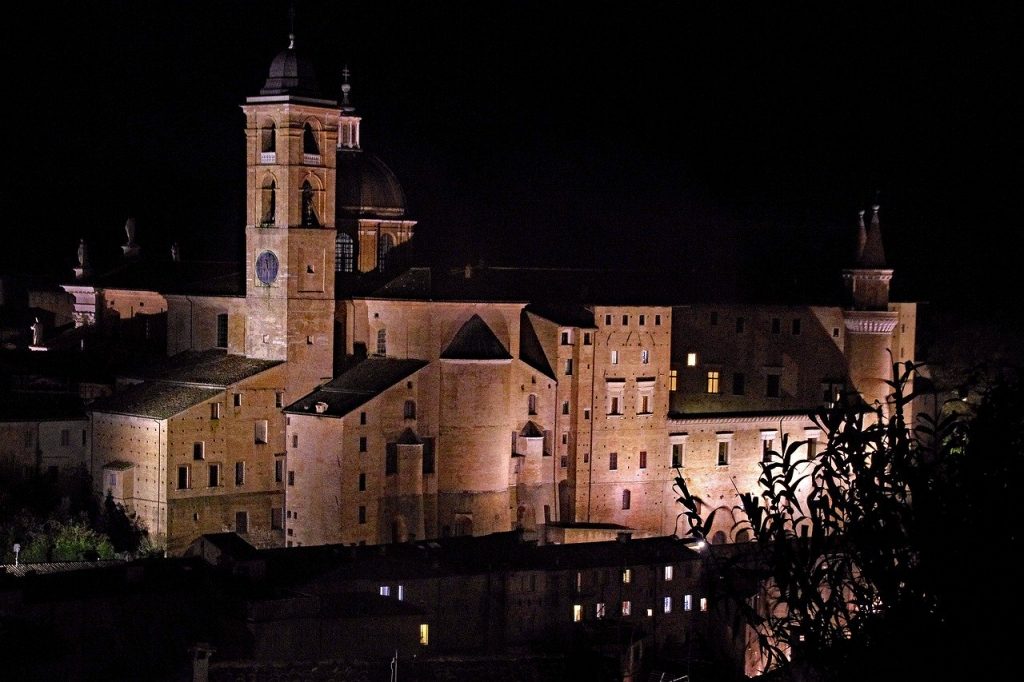
One of Italy’s UNESCO world heritage site since 1998, Urbino was one of the most important centres of the Italian Renaissance and today, still enjoys a perfectly preserved historic centre. Dating back to Roman times, Urbino’s heyday owes much to the Montefeltro family who welcomed numerous writers and artists to the town including Piero della Francesca and Joos Van Ghent. It was also home to Raphael. Of note for visitors today is the Palazzo Ducale, home to Urbino’s main museums, Casa Natale di Raffaello (Raphael’s birthplace and where many of his early works are displayed), the Duomo and San Domenico.
Ivrea
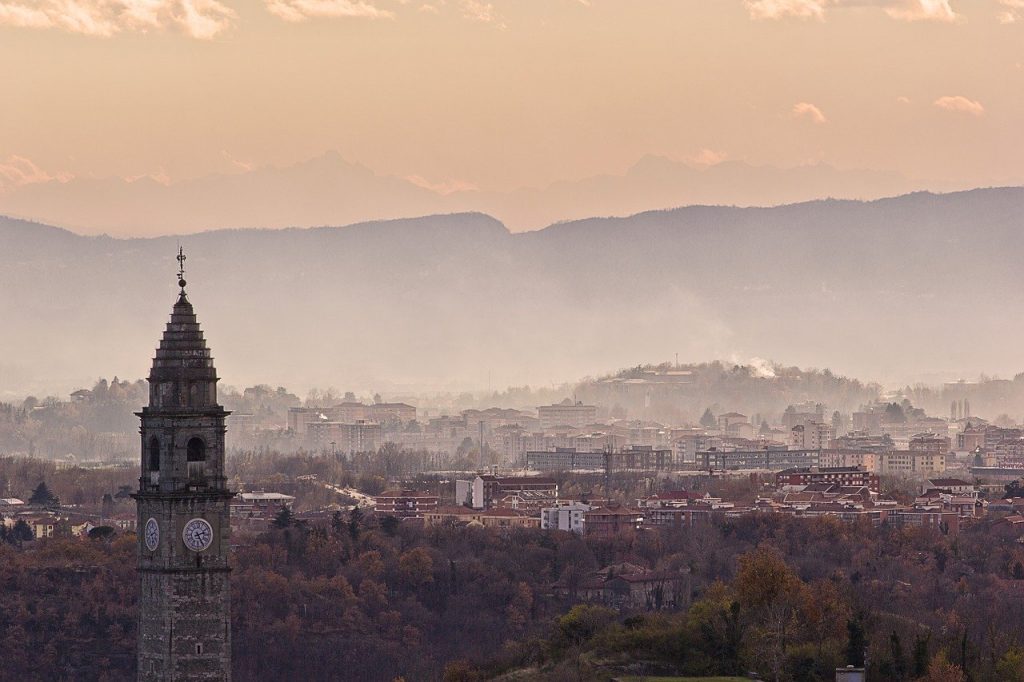
Located in Piedmont, Ivrea is arguably one of the least visited Italian UNESCO world heritage sites, at least by tourists. Ivrea is a 20th century industrial city founded in 1908 by Camillo Olivetti whose company manufactured typewriters, mechanical calculators and office computers. It was chosen as a UNESCO World Heritage site as it is ‘an ensemble of outstanding architectural quality’ representing ‘the work of Italian modernist designers and architects’ and demonstrating ‘an exceptional example of 20th century developments in the design of production, taking into account changing industrial and social needs’. It comprises a large factory and buildings as well as residential units.
Late Baroque Towns of the Val di Noto, Sicily
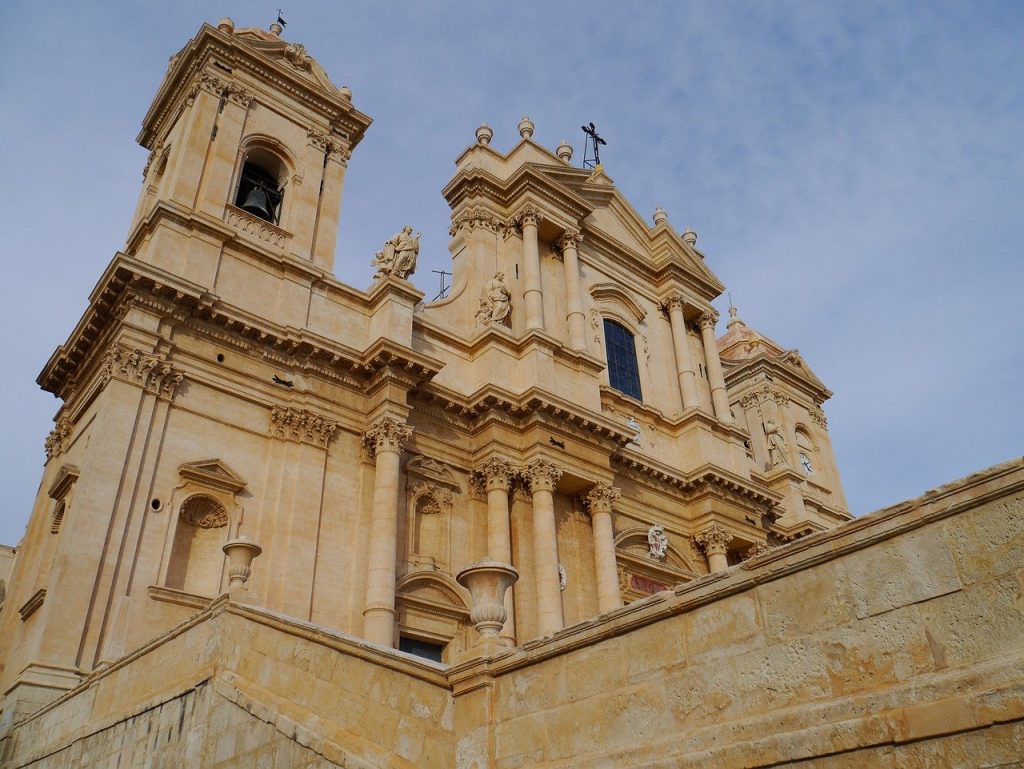
This Sicilian UNESCO world heritage site is comprised of eight towns – Caltagirone, Militello Val di Catania, Catania, Modica, Noto, Palazzolo, Ragusa and Scicli. All were rebuilt after 1693 either on or existing towns that had been damaged or destroyed by an earthquake of the same year. All are built in a late Baroque style.
Mantua and Sabbioneta
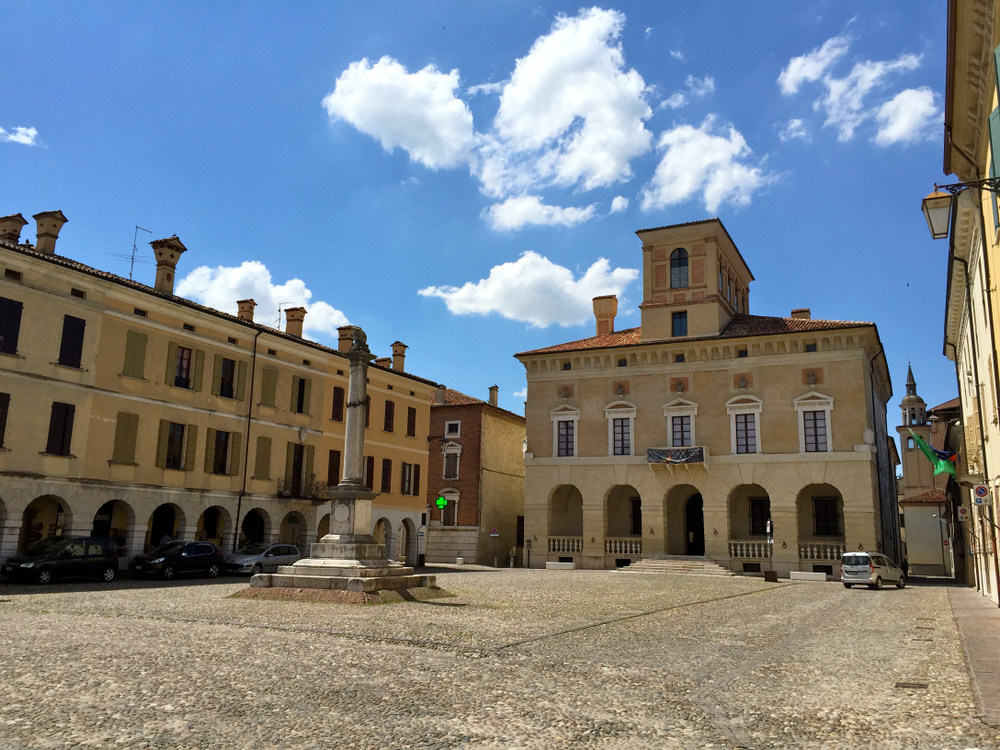
Situated in the Po Valley and spaced 30 km apart, both Mantua and Sabbioneta are important examples of Renaissance town planning. Both owe much to the Gonzaga family.
Mantua is a great example of how an existing city was renewed and extended in the Renaissance period whereas Sabbioneta was a completely new creation, modelled on Renaissance and humanist ideals. Visitors to Mantua will discover a plethora of palazzi, piazzas, porticoes and courtyards. Of particular note are the Duomo, the Palazzo Vescovile, Palazzo Castiglioni, Palazzo Te, and the Palazzo Ducale, the main residence of the Gonzaga family where amongst over 500 other rooms, you will find the incredible Bridal Chamber (Cameria degli Sposi) adorned with Mantagena’s 15th century frescoes. But there are many more incredible buildings here to admire.
In Sabbonieta, the main points of interest include the Porta di Accesso Imperiale, the Porta della Vittoria, the Galleria degli Antichi, the Teatro Olimpico, the Palazzo Ducale and Palazzo Giardino.
Longobards in Italy, places of power 568-774 AD
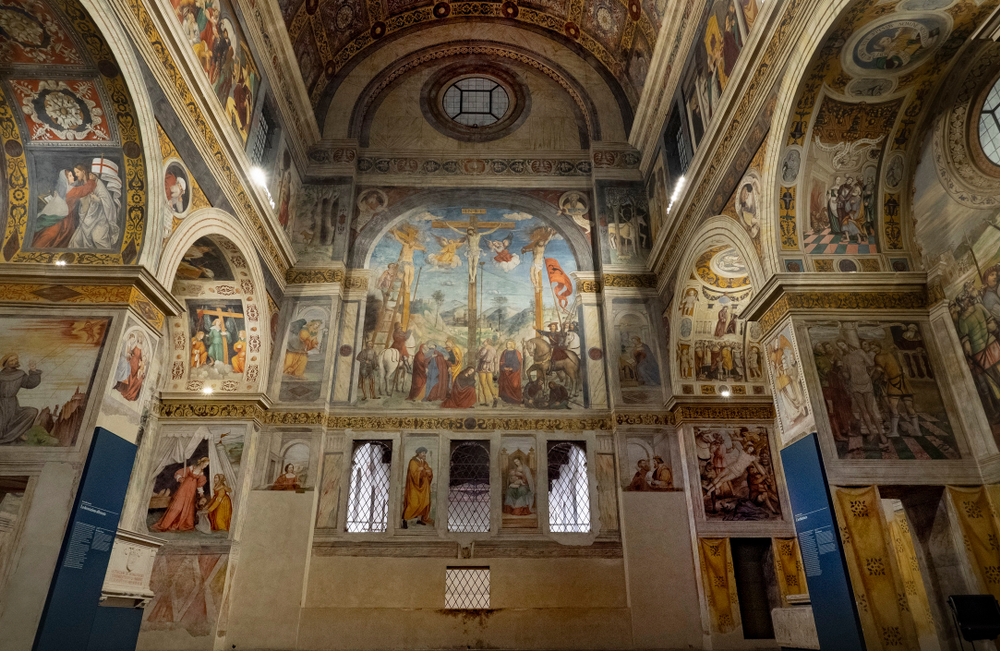
The longobards are a collection of seven important buildings that embody the values of the Lombard people. These were Germanic tribes who have converted to Christianity and who migrated from the North and settled in Italy between the 6th and 8th centuries AD. The buildings include fortresses, churches and monasteries. They were influenced not just by the values that they inherited from the Roman world but also by Byzantine, Hellenistic and Middle Eastern cultures.
The monuments include the Gastaldaga area and episcopal complex at Cividale, the monastic complex of San Salvatore-Santa Giulia in Brescia, the Castra with Torba Tower and church at Castelseprio, the Basilica of San Salvatore in Spoleto, the Clitunno Tempietto in Campello sul Clitunno, the Santa Sofia complex in Benevento and the Sanctuary of San Michele at Monte Sant’Angelo.
Medici Villas and Gardens in Tuscany
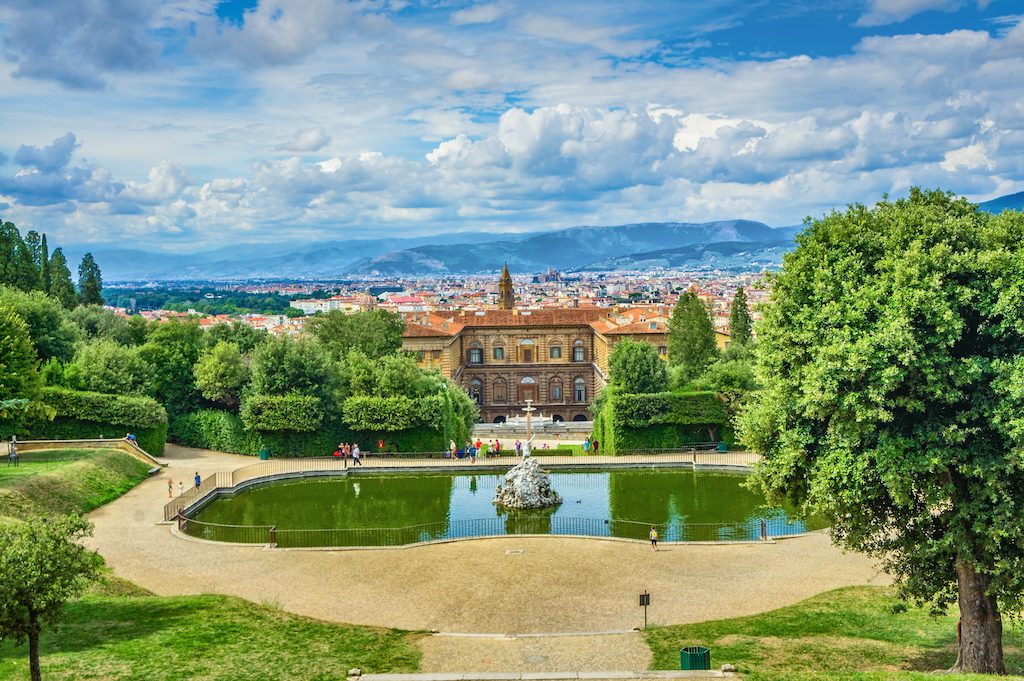
Twelve villas and two gardens make up this Italian UNESCO world heritage site. The gardens include the Boboli Gardens in Florence and the Pratolino Gardens in Vaglia. The villas are all perfect examples of Tuscan Renaissance and Baroque architecture and include those of Careggi, La Petraia, Castello and Poggio Imperiale in Florence, the Belcanto Villa in Fiesole (also known as Villa Fiesole), the Poggio a Caiano Villa in Prato, the Villa in Cerreto Guidi, Villa La Magia near Pistoia, Villa di Artimino near Prato, Cafaggiolo a Barberino in Mugello, Villa del Trebbio in San Piero in Sieve and, finally, Palazzo di Seravezza in Lucca.
The Medici Family had a huge influence on modern European culture from the 15th to 17th centuries through their extensive patronage of the arts. These villas served as their hunting lodges, diplomatic residences and places to live well! These days the villas and gardens have different uses and many are now home to key museums.
Piazza del Duomo, Pisa
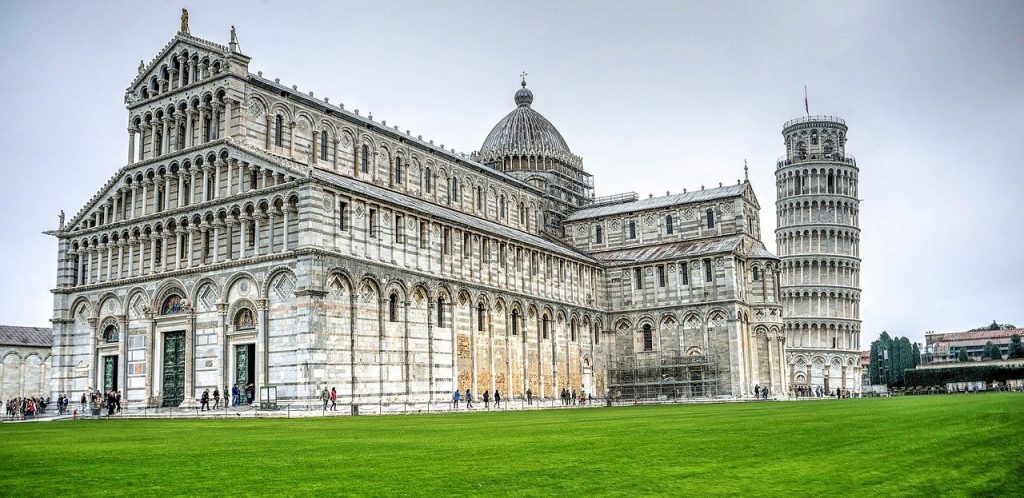
Also known as the Piazza dei Miracoli, the Piazza del Duomo in Pisa is home to four key structures – the famous Leaning Tower of Pisa (Campanile), the Camposanto, the Battistero and the Duomo. The oldest of these is the cathedral constructed in 1064. In front of this sits the Baptistery, the largest in the world standing at 55 metres tall and with a circumference of over 100 metres. The Camposanto is to the North of the piazza and is now home to an art and archeology museum. And last but not least, the Leaning Tower needs no introduction. Head inside up the 294 steps to the top to admire the view.
Portovenere, Cinque Terre and the Islands (Palmaria, Tino and Tinetto)
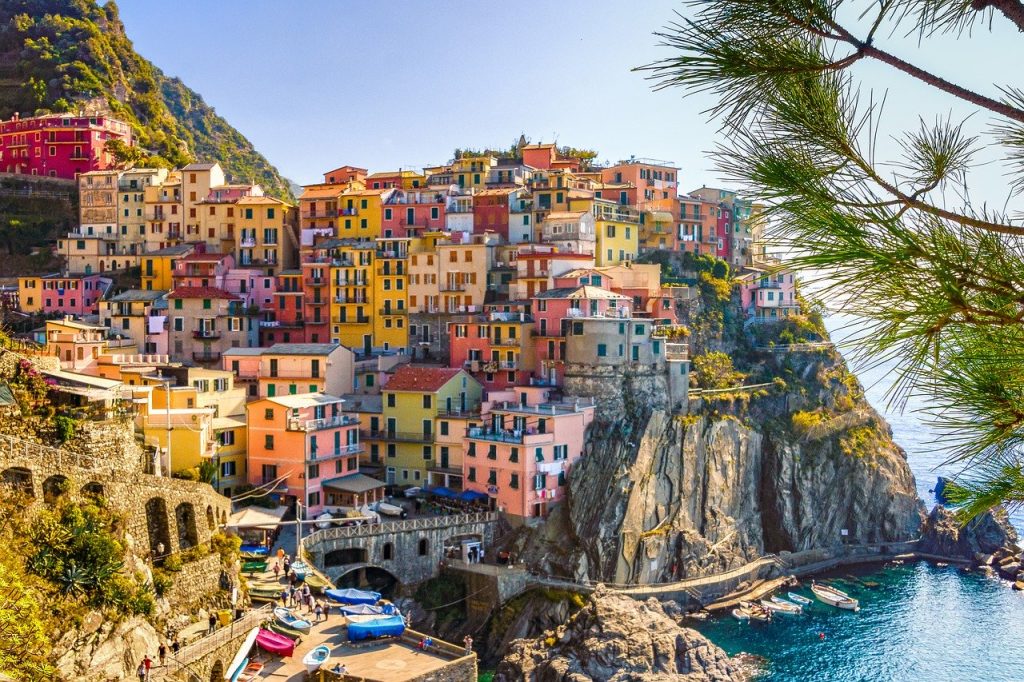
The Cinque Terre is comprised of multi-coloured seaside villages nestled between cliffs in the Liguria region of Italy and connected by coastal paths. There are five in total -Monterosso, Vernazza, Corniglia, Manarola and Riomaggiore. Monterosso is famous for its elegant villas, narrow streets (caruggi) and stunning beach. Vernazza is dominated by the Doria Castle which sits above it, historically defending the townsfolk from naval attack. Corniglia is connected to the beach by 365 steps and the town is famous for its cultivation of wine and terraces of vines. Manarola sits on top of a massive pile of black boulders and is famous for its passito wine – sciachetra – and its olive oil. Finally, Riomaggiore is a picturesque fishing village with tall pastel-coloured houses.
This Italian UNESCO World Heritage Site also includes Porto Venere, a popular and elegant seaside resort, and the three islands of Palmaria, Tino and Tinetto. The most popular (and largest) of these is Palmaria who head to the island to explore the famous Blue Grotto (Grotta Azzurra) by boat.
Prehistoric Pile dwellings around the Alps
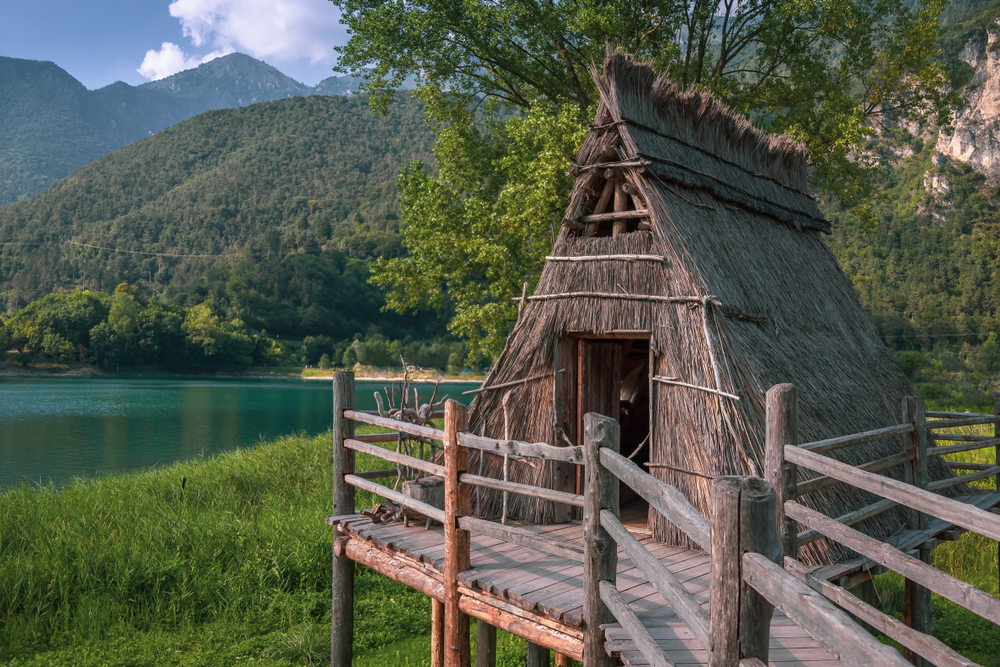
This particular UNESCO world heritage site includes 111 prehistoric pile dwellings around the Alpine and sub-alpine regions of Europe composed of the remains of prehistoric settlements dating from 5,000 to 500 BC. Nineteen of these are in Italy with the remaining dwellings situated in Switzerland, France, Austria, Germany and Slovenia. Of those in Italy, ten are in Lombardy, four in Veneto, two in Piedmont, two in Trentino Alto Adige and one in Fruili Venezia Giulia. The dwellings are situated under water, on the shores of lakes, along rivers or in wetlands. They provide a glimpse of what life would have been like in prehistoric times during the Neolithic and Bronze Age in Alpine Europe.
Primeval Beech Forests of the Carpathians and Other Regions of Europe
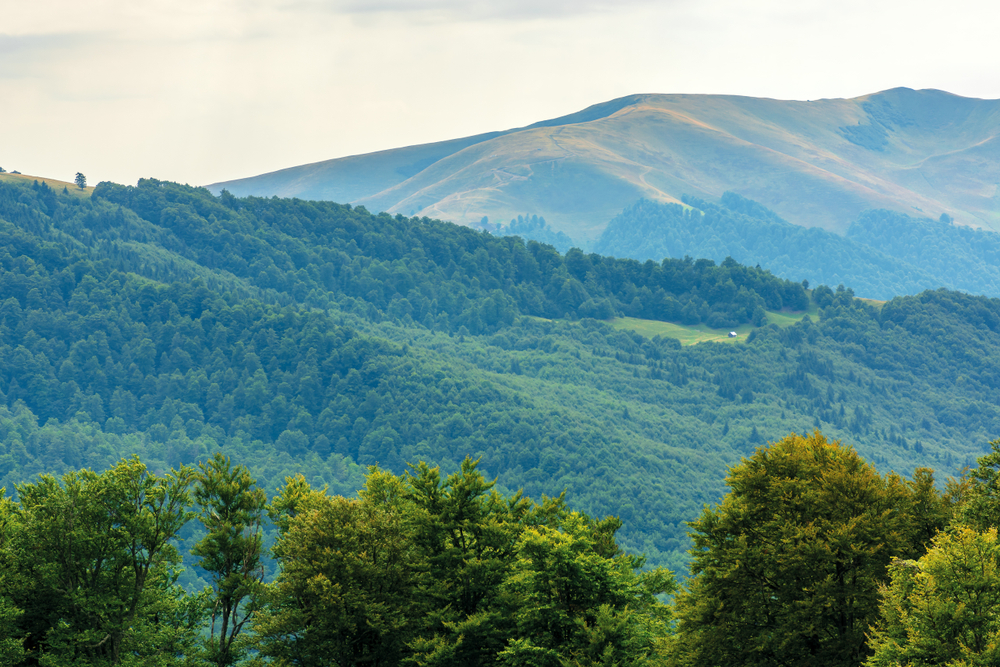
This UNESCO site actually covers not just Italy but 11 other countries as well. Ten ancient Italian beech forests extending from Tuscany to Basilicata fall within this world heritage site, deemed to offer ‘exceptional naturalistic value’ and ‘incredible biodiversity’. These include the Casentinesi forests in Emilia Romagna, the forests of the Abruzzo, Lazio and Molise National Parks, Pescasseroli and Opi in Abruzzo, the forests of Monte Cimino and Monte Raschio in Lazio, the Umbra Forest in the Gargano National Park in Puglia and the Cozzo Ferriero Forest in Basilicata in the Pollino National Park.
Residences of the Royal House of Savoy, Turin, Piedmont
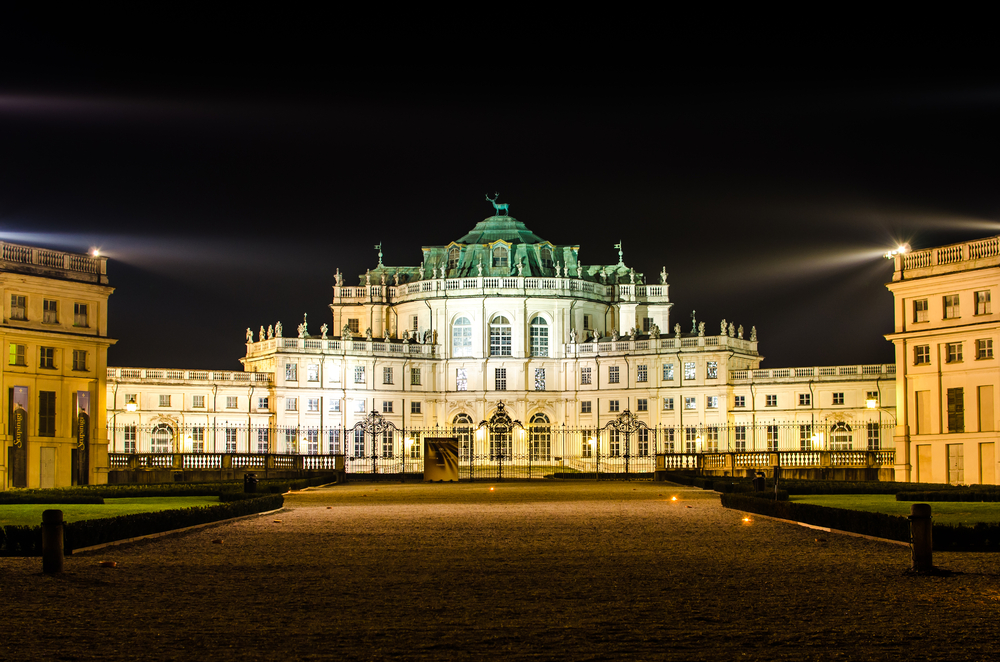
A UNESCO world heritage site since 1997, the Residences of the Royal House of Savoy are a group of of buildings in Turin, all considered to be of great historical, artistic and environmental value. In the past they were all official residences for the royal family. The most famous of the buildings is the Royal Palace, now home to a museum where visitors can learn more about the royal family. The site also includes the Palazzo Carignano in the heart of Turin, now home to the National Museum of the Risorgimento, and the Palazzo Madama, which now houses the Civic Museum of Ancient Art. Other buildings include the Castello del Valentino, Borgo Castello, the Royal Palace of Venaria, the Royal Castles of Moncalieri, Rivoli and Aglié, the Hunting Lodge of Stupinigi, the Royal Castle of Racconigi, the Castles of Pollenzo and Govone, and the Residence of Valcasotto.
Rhaetian Railway in the Albula / Bernina Landscapes
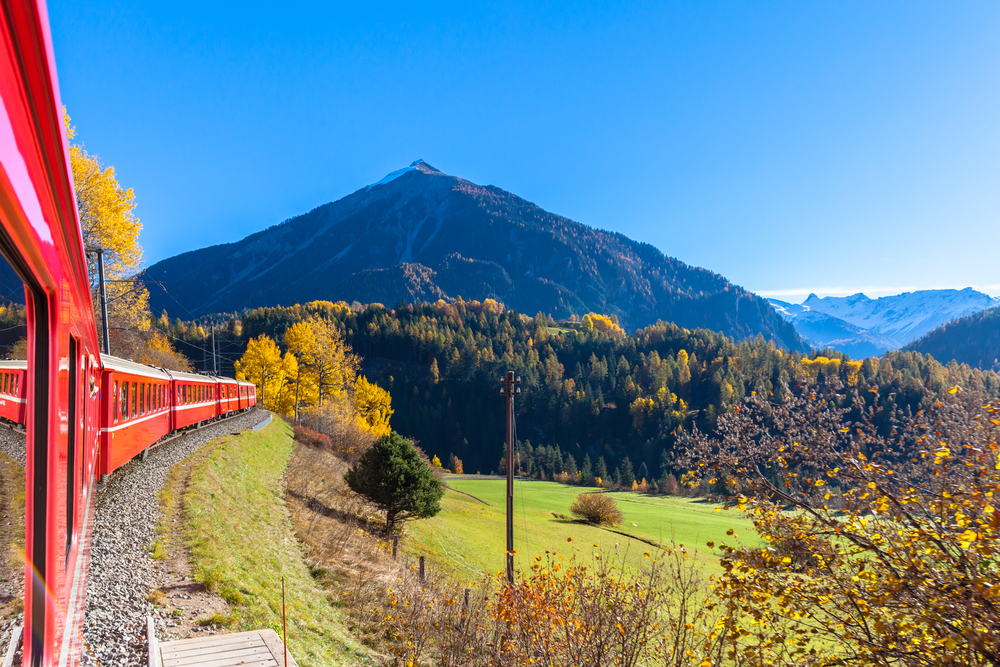
The Rhaetian railway connects Italy with Switzerland through valleys and mountain passes. The particular part of the railway that has been a UNESCO world heritage site since 2008 was completed in the early 1900s and brought an end to the isolation that the mountain community had previously lived with. It’s an incredible feat of engineering and is, without doubt, one of the most beautiful train journeys in the world with spectacular views.
Sacri Monti of Piedmont and Lombardy
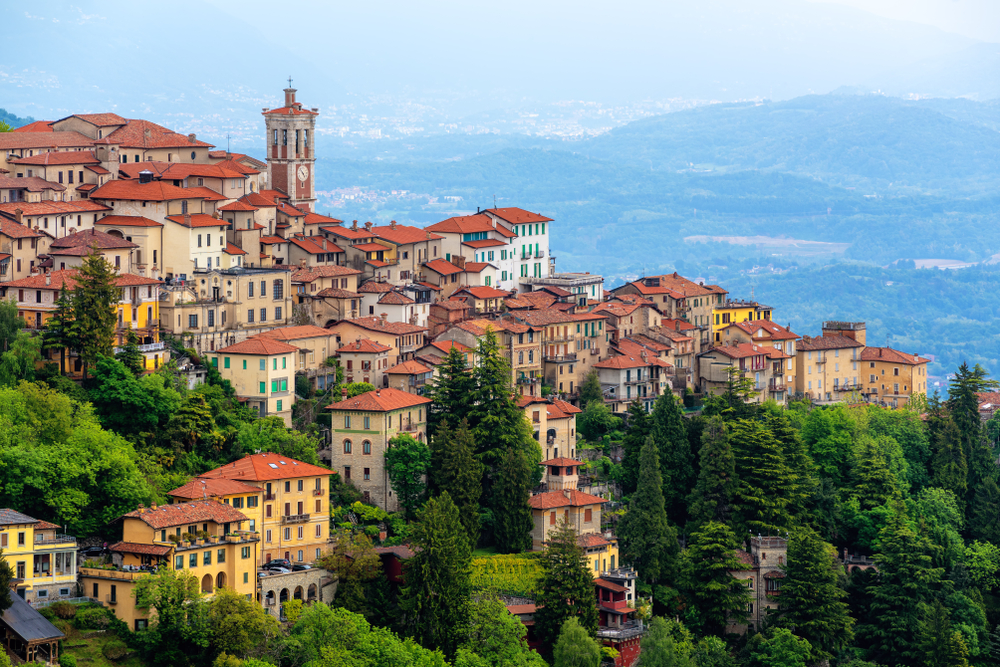
These are a group of nine chapels and religious complexes whose construction began in the late Middle Ages as a way for the religiously devout to enjoy a safer pilgrimage experience since it was increasingly difficult to journey to the Holy Land. The project was promoted by Carlo Borromeo, Bishop of Milan. The nine complexes – Varallo, Crea, Orta, Varese, Oropa, Ossuccio, Ghiffa, Domodossola, and Valperga – are all found in the mountains of Northern Italy. Inside, they contain a number of preserved frescoes, statues and paintings. Even for the non religiously devout, a visit can be immensely enjoyable, not least because of the stunning landscape in which they are found.
Su Nuraxi di Barumini, Sardinia
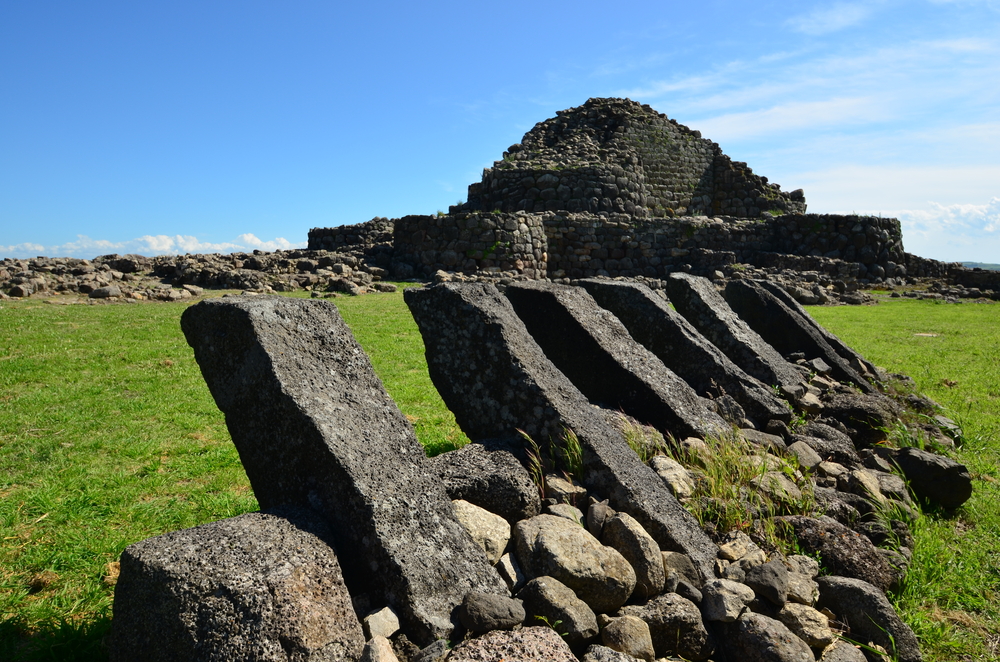
Situated in the centre of Sardinia, the Su Nuraxi di Barumini is an excellent example of a type of prehistoric architecture from the Bronze Age called nuraghi. The site was a complex village settlement which, at its centre, was a tall 60 foot tower with a spiral staircase that connected the three levels. Unfortunately the top level of the tower has not survived. The settlement was also home to four other towers linked by a wall whilst a second outer wall provided additional protection for the villagers within. Visitors today can still see the remains of the settlement huts where the villagers would have lived.
Syracuse and the Rocky Necropolis of Pantalica
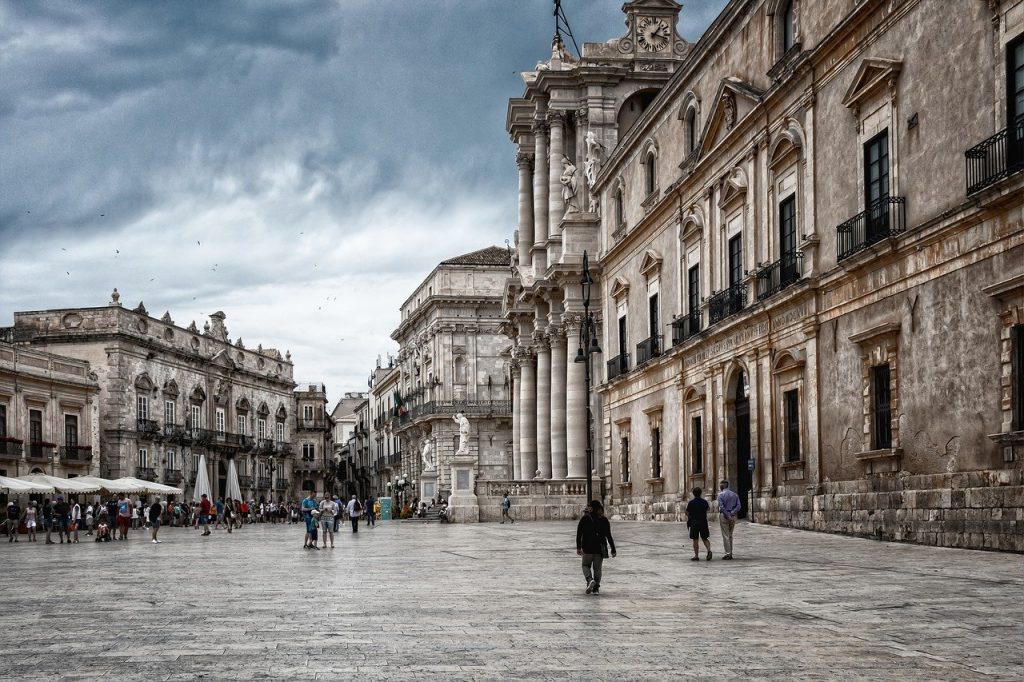
This site consists of two separate elements, both dating back to ancient Greek and Roman times. Cicero described Syracuse as “the most beautiful city in Magna Graecia’ and it remains incredibly beautiful even today. The birthplace of esteemed Greek mathematician, Archimedes, and A UNESCO world heritage site since 2005, the historic centre of Syracuse should be on everyone’s Italian bucket list. Some particular places of note in the centre include the Temple of Athena dating back to the 5th century BC, but which was later transformed to serve as a cathedral, a Greek theatre, a Roman amphitheatre and a fort.
The nearby Necropolis of Pantalica sits near open stone quarries and contains over 5,000 tombs dug into the rock along with along with the Anaktoron (Prince’s Palace) situated at the top of a hill. They date back to a period that goes from the 13th to 7th century BC. Today, the area is also a natural oasis which is filled with anemones, orchids, and oleanders as well as several different animal species.
Trulli of Alberobello
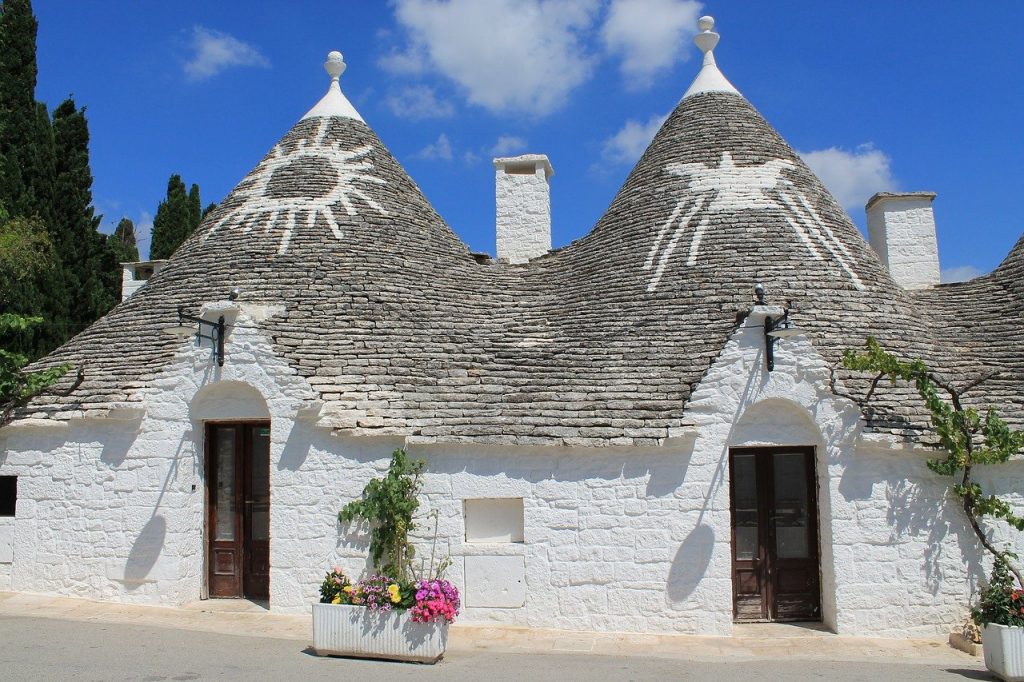
Alberobello has been a UNESCO world heritage site since 1996, boasting near to 1500 trulli (cone shaped dwellings) that date back to the 1400s. The town is divided into two main parts – Monti and Aia Piccola. The Trullo Sovrano is the largest trullo in Alberobello, boasting two internal floors linked by a winding staircase.
Val d’Orcia
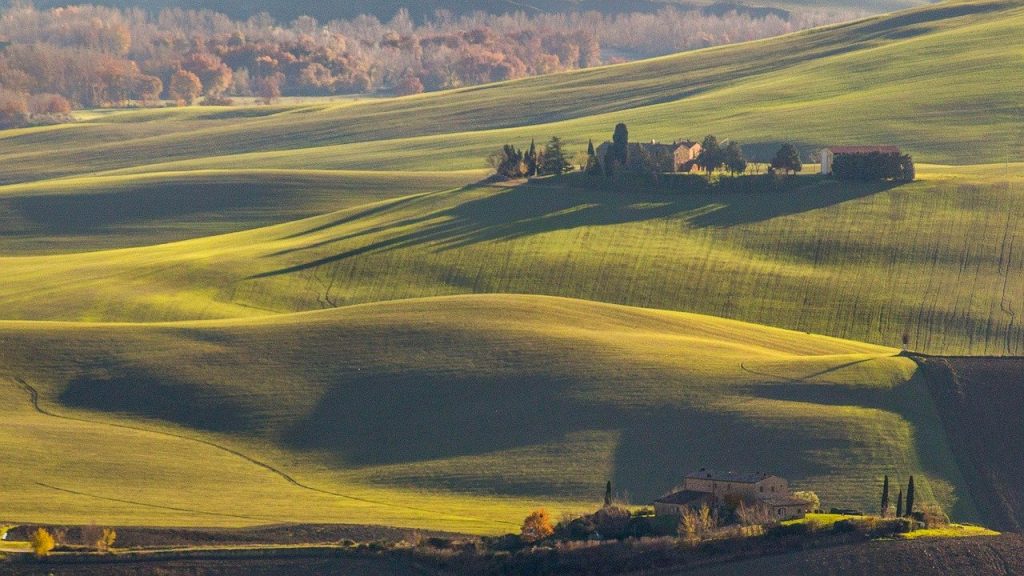
The Val d’Orcia in the South of Tuscany is the picture postcard image you conjure up when you think of Tuscany. Characterised by gently rolling grassy hills interspersed with vineyards, olive groves, cypress, beech and chestnut trees and dotted with Medieval hamlets, stunning villas and ancient castles, it has a breath-taking natural beauty. Its UNESCO world heritage status means that this landscape will remain unspoilt for years to come.
Venice and its lagoon
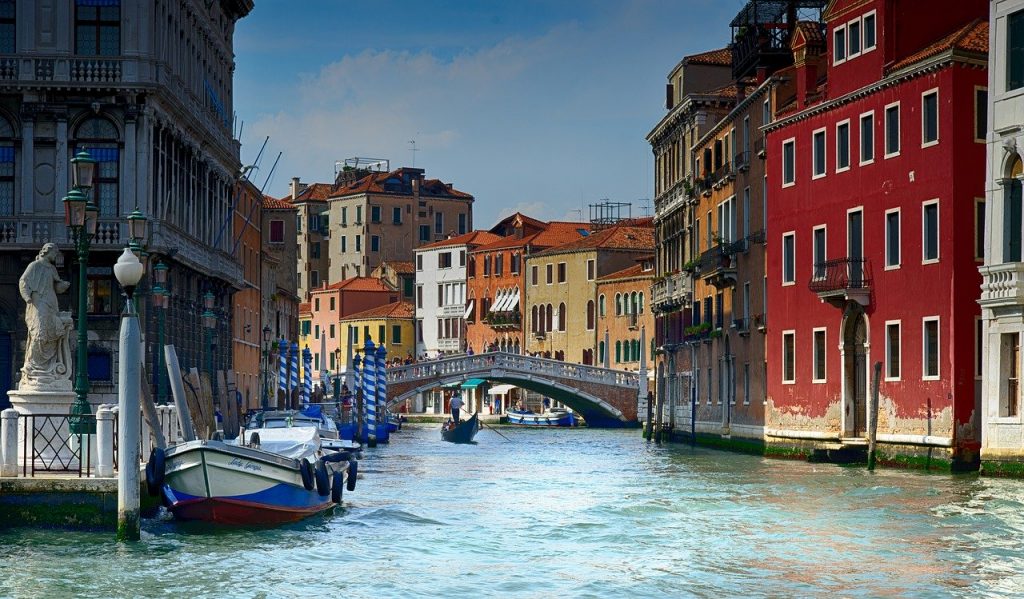
Measuring an area of over 50,000 square kilometres and including Venice as well as 118 small islands, the city of Venice is an extraordinary architectural gem, home to countless works by some of the world’s greatest artists including Giorgione, Titian, Tintoretto and Veronese.
Some of the most famous sights include St Marks’ Square (Piazza San Marco), home to St Mark’s Basilica, whose interior is covered in an incredible array of gold mosaics depicting Bible scenes. Adjacent is the Ducal Palace (Palazzo Ducale) whilst also in the piazza is the Campanile di San Marco (Bell Tower). The bridges of Venice are also famous, the most famous amongst them being the Ponte Rialto and the Bridge of Sighs (Ponte dei Sospiri). Also of note is the Arsenale, the Jewish Ghetto and Venice’s museums and art galleries. Of the islands within the lagoon, the most widely known and visited are Murano and Burano. Head to the former to learn more about the world-famous Murano glassware and the latter to see the highly colourful buildings that line the canals.
Venetian Works of Defence between the 16th and 17th centuries: Stato da Terra – western Stato da Mar
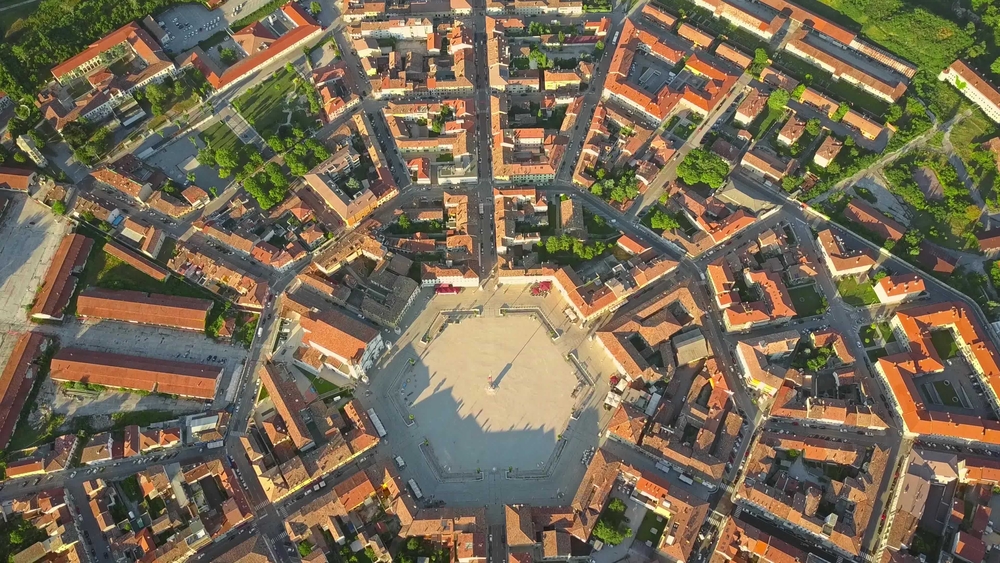
The Venetian Works of Defence are a collective term for the extensive defence networks built by the Serenissima. Three of these fall within Italian borders.
The first of these are the defensive walls of Bergamo built in the 16th century, which stretch for over 6 kilometres, reaching heights up to 50 metres and featuring four large gateways that provide access to Bergamo’s historic centre. The second is a five-sided fortress in Peschiera del Garda on Lake Garda, with five bastions and two entrances, protecting the old town. Last but not least is Palmanova, a star-shaped fortress in Friuli-Venezia Giulia built to defend its borders from both Ottoman and Austrian threats.
Villa d’Este, Tivoli
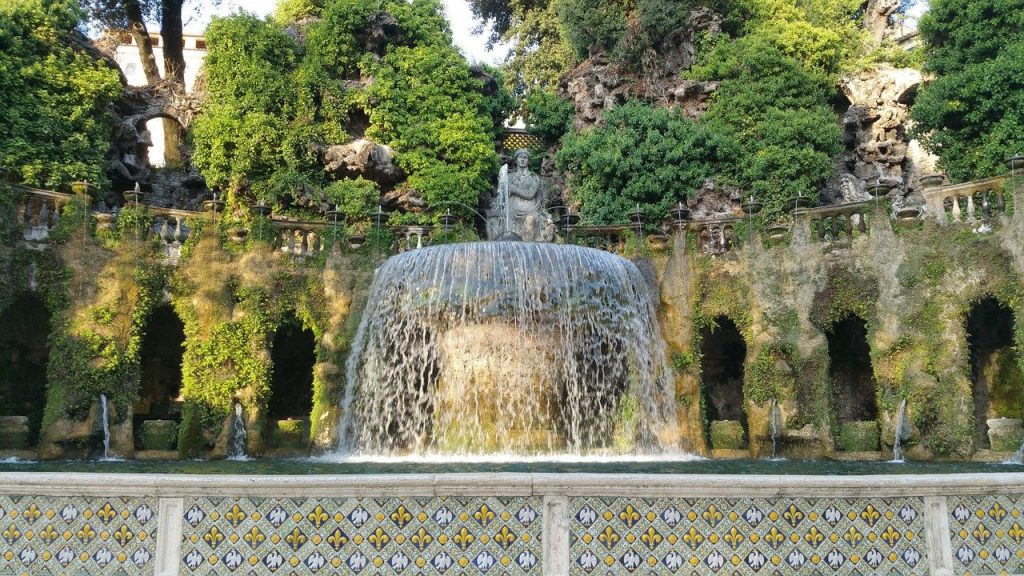
A 16th century Renaissance masterpiece, Villa d’Este is situated just outside Rome and is famous for its Italian Renaissance gardens, filled with fountains. It has served as the backdrop for many films over the years including Ben Hur and has provided inspiration to numerous artists including Franz Liszt, who composed ‘Water Games at Villa d’Este’ during his stay here.
Villa Adriana, Tivoli
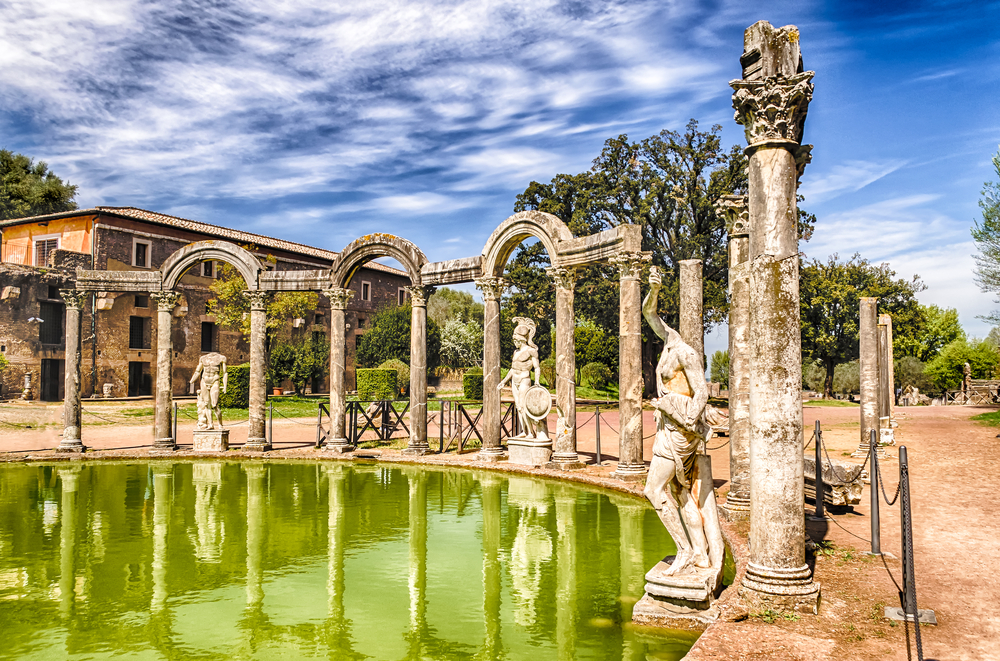
Also in Tivoli is Villa Adriana, built in the 2nd century A.D. for the Roman Emperor Hadrian who could use it as a base to rule Rome, since it provided easy access to the city via the ancient Roman roads – Tiburtina and Prenestina – or alternatively via the River Aniene. Visitors can still find the sulphur springs – the Tivoli Baths – that would have been one of the other attractions for choosing this location.
Villa Romana del Casale, Sicily
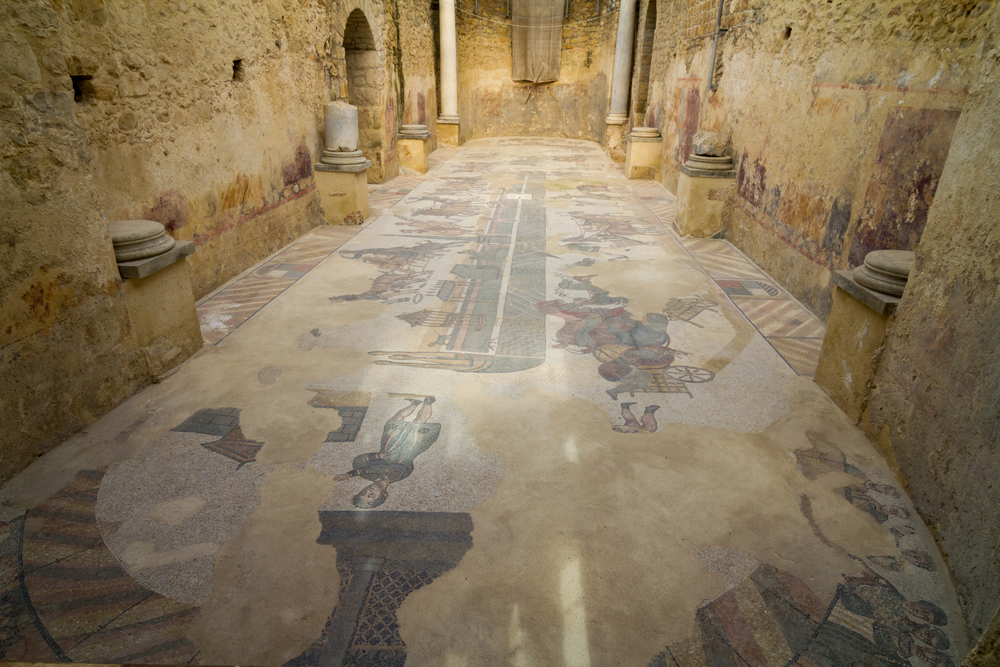
Situated in Piazza Armerina, the Villa Romana del Casale dates back to the 4th Century A.D. and was once the home of a powerful Roman family. Today, visitors can explore several different parts of the villa including the spa complex, the porticoed, entrance courtyard and honorary arch, the vestibule and central courtyard, the servants quarters and the Palestrite room, the formal dining room (triclinium), the basilica and both the Northern and Southern apartments. Incredibly well-preserved mosaics can be seen throughout both on the walls and on the floor.
Vineyard Landscape of Piedmont: Langhe-Roero and Monferrato
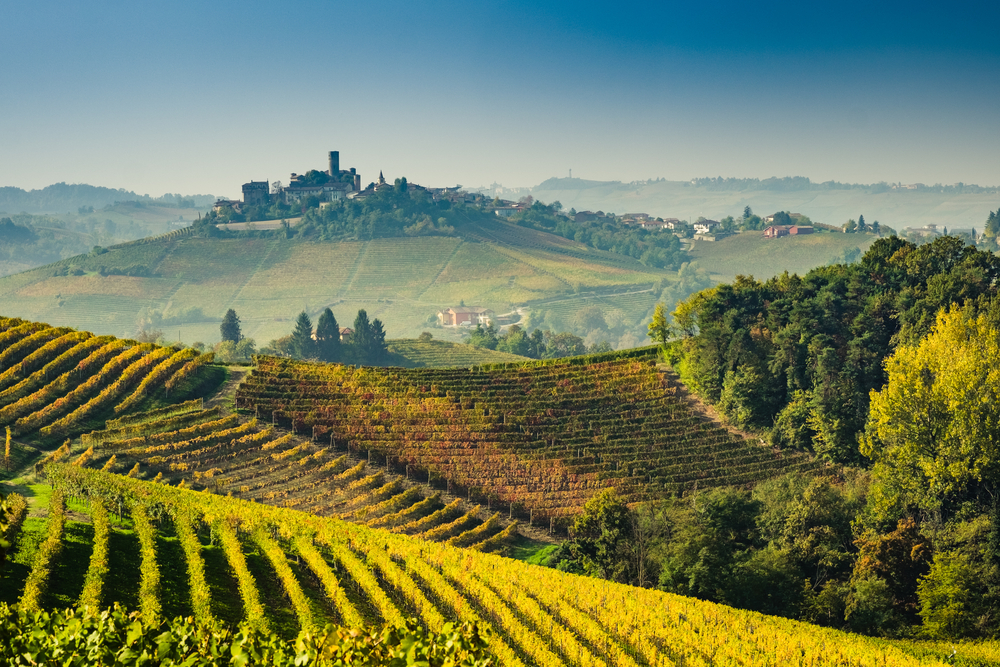
Italy is the biggest wine producer in the world so it’s perhaps not surprising that its wine-growing regions have also secured their place in the UNESCO world heritage list. This zone incorporates six main wine growing regions over an area of 10,000 hectares. The wines produced here include Barolo, Barbaresco, Asti Spumante (one of the biggest wines to be exported from Italy) and Barbera d’Asti. Visitors can enjoy visits to individual wineries to sample the wines accompanied by some of the region’s finest produce. The area is also famous for its truffles. Alba has an annual white truffle festival which attracts visitors from all over the world.
The Prosecco Hills of Conegliano and Valdobbiadene. (‘Le Colline del Prosecco di Conegliano e Valdobbiadene‘)
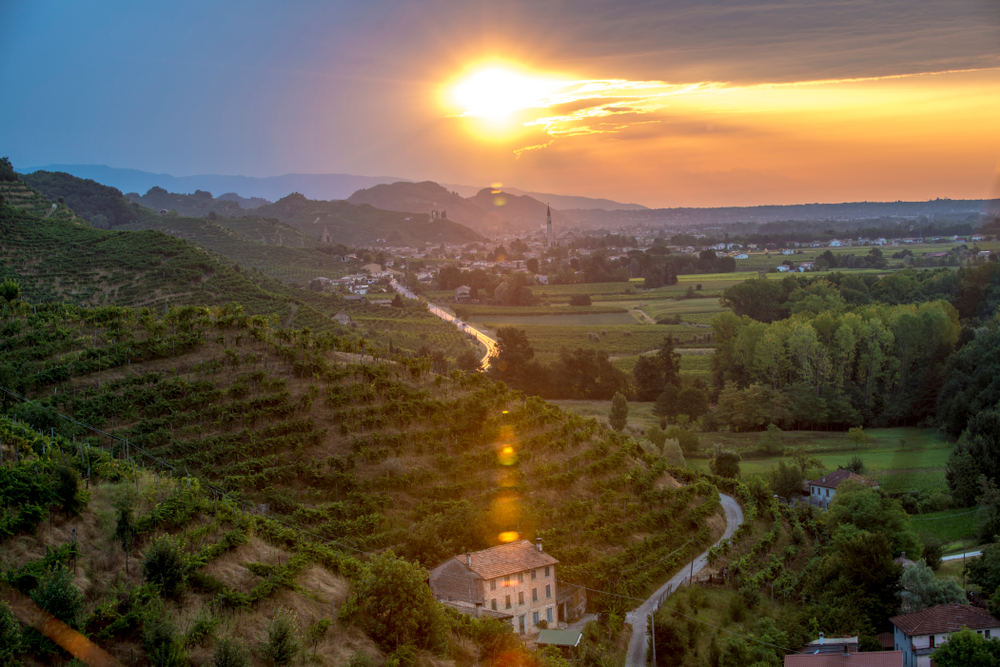
The most recent addition to the list of UNESCO world heritage sites, the Prosecco hills situated between Conegliano and Valdobbiadene, in the North East of Italy, are home to the production of Prosecco di Conegliano-Valdobbiadene DOCG. With 90 million bottles of the sparking wine produced each year, the prosecco industry is experiencing a real boom.
Isole Eolie (Aeolian Islands)
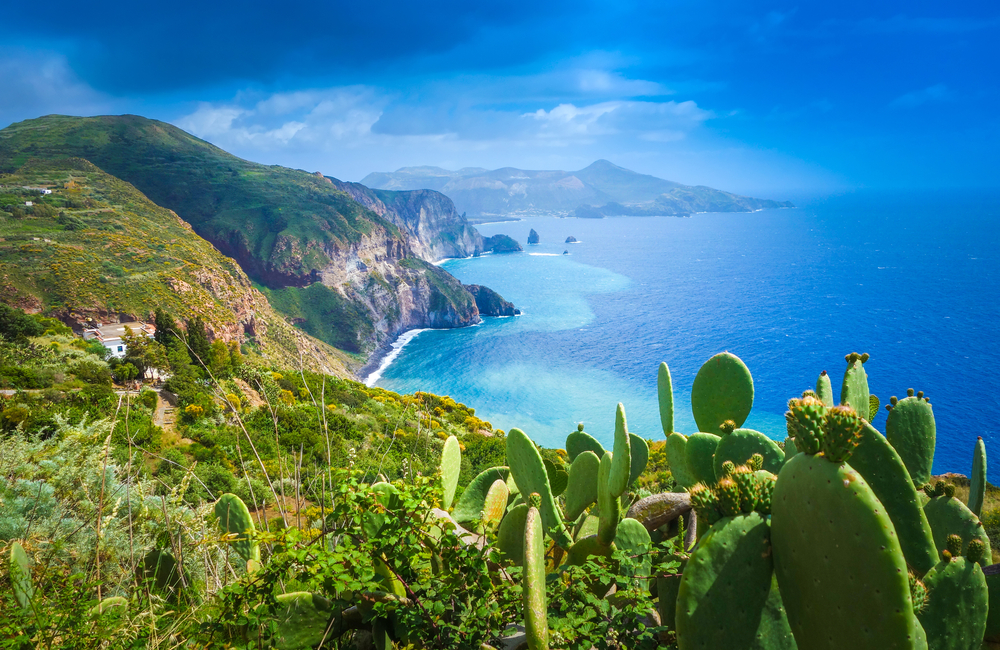
Seven islands in total make p the Aeolian Islands, situated just off the coast of Sicily. These are Lipari, Panarea, Vulcano, Stromboli, Salina, Alicudi and Filicudi. All were created by still-active volcanoes and are visited by thousands of tourists each year. The largest of these is Lipari, home to a superb archaeological museum, a Greek acropolis and Norman cathedral but probably its prettiest spots and inlets are explored by boat. The next largest is Salina, home to gorgeous beaches nestled below striking cliffs. In contrast, Panarea is the smallest of the islands but attracts visitors keen to experience its clean water and underwater volcanic vents. Vulcano, as the name suggests, is where you can explore numerous volcanic phenomenons, from smoke clouds to sulphuric mud holes. Stromboli is home to Europe’s most active volcano and it is often possible to see the lava flowing from its summit into the sea below. Finally, Alicudi and Filicudi are the most naturally wild of the islands, least touched by humans.
The porticoes of Bologna
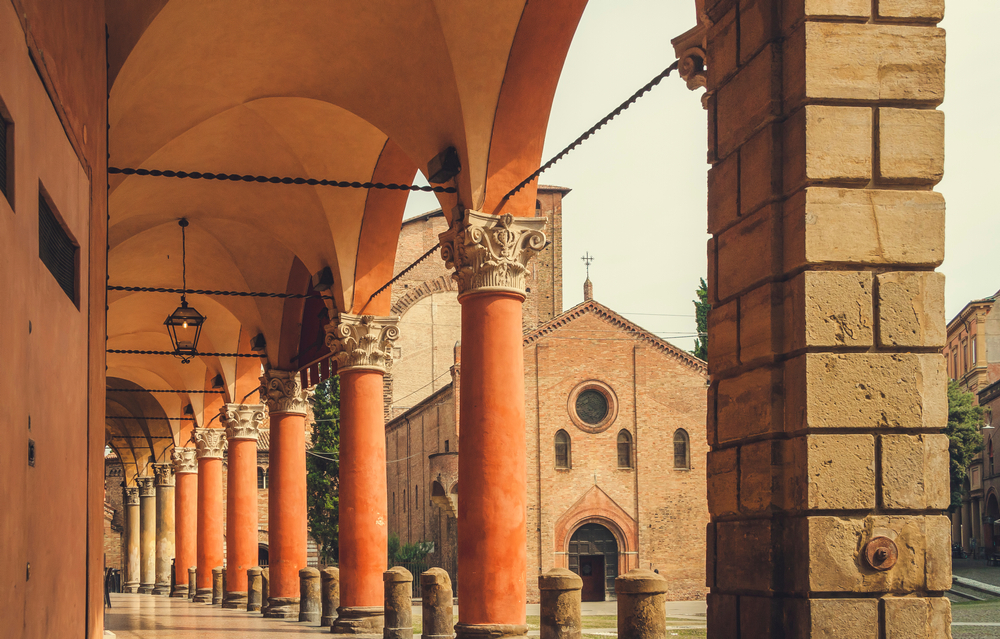
One of the most recent additions to Italy’s UNESCO sites, in July 2021 Bologna’s extensive network of porticoes that line Bologna’s streets were described by a UNESCO representative as an, ‘outstanding example of a building type, architectural or technological ensemble or landscape that illustrates one or more important phases in human history.’
Bologna can boast a staggering 40 km of covered porticoes, built from either wood, stone, brick or concrete. With over 600 arches, the portico that leads from the city to the San Luca is the longest and most famous but there are porticoes that jut out of almost every building in the heart of Emilia Romagna’s capital city. Originally this network of arcades were intended to create additional living spaces in the Middle Ages, but you’ll now find that they’re a perfect way to avoid the rain whilst sightseeing or even to escape from the heat of the midday sun! An important university town, they also provide accommodation for Bologna’s students, with many lodgings built on top of them to accommodate Bologna’s burgeoning population.
Find out more about what to see and do in Bologna on our Bologna travel guide.
Padua’s 14th century frescoes
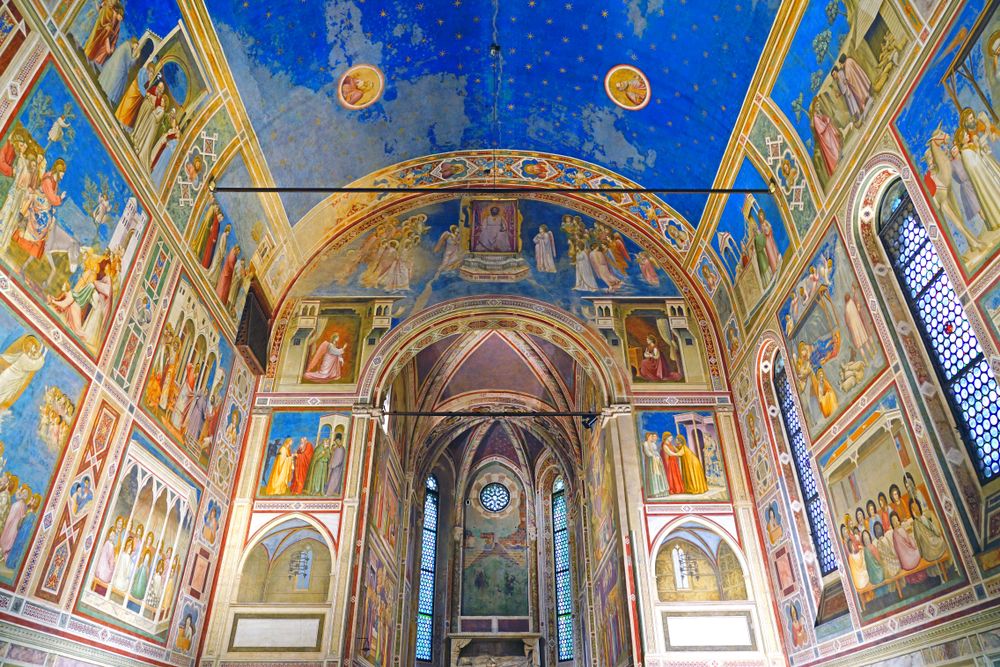
Added in 2021, this UNESCO World heritage site includes eight religious and secular building complexes within the beautiful walled city of Padua (Padova Urbs Picta), which are home to a selection of fresco cycles painted between 1302 and 1397. The works include Giotto’s Scrovegni Chapel fresco cycle, as well as frescoes by artists such as Guariento di Arpo, Giusto de’ Menabuoi, Altichiero da Zevio, Jacopo Avanzi and Jacopo da Verona. Whilst they may have been painted by a number of different artists for a number of different patrons and within a diverse set of buildings, these fresco cycles demonstrate how, over the course of a century, fresco art developed in UNESCO’s words ‘along a new creative impetus and understanding of spatial representation’.
The great Spa Towns of Europe
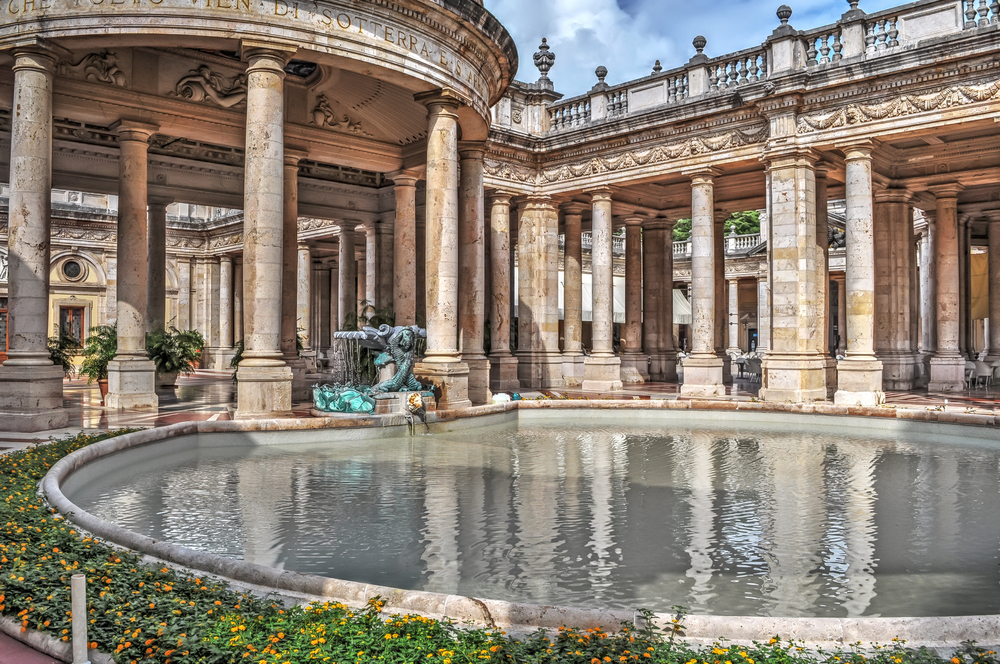
Another UNESCO World Heritage site to be added in 2021 – the Great Spa Towns of Europe – includes 11 towns in seven different European countries, one of which is Montecatini Terme in Italy. The thing that links all these towns is that they developed around natural mineral water springs and bear testament to the international European spa culture that was prevalent between the early 18th century and the 1930s. Montecatini Terme itself is a Medieval hillside town situated between Lucca and Florence, characterised by pretty streets lined and charming piazzas. The renowned waters of the town are found at the base of the hill.
